Introduction
This review of birds in the Republic of Korea (ROK) in 2010 was compiled and written by Tim Edelsten with additional input and editing by Nial Moores; review of selected records by Shim Kyu-Sik; and online layout by Andreas Kim. Taxonomy, order, nomenclature and threat status follow the 2013 Birds Korea Checklist (Moores & Kim 2013) accessible at: http://www.birdskorea.or.kr/Birds/Checklist/BK-CL-Checklist-May-2013.shtml
As explained previously, the Birds Korea Year Reviews aim, year by year, to close information gaps, to improve understanding of the status of the national avifauna and to support international efforts for conservation. Of the 410 or so species recorded in total during 2010 in the ROK, this review contains records of 199 species considered to be of especial note, including three exotics. The 199 species were selected because of e.g. their global or national conservation status; and / or because of exceptional counts or dates; and / or because they were recorded nationally or at well-watched sites for the first time. A large number of these records came from Birds Korea research on seabirds at sea and especially on Socheong Island, where there was near-daily coverage through April and May (Birds Korea 2010, Moores 2012); from ongoing research by the Migratory Bird Research Centre on Hong and Heuksan islands; and from Birds Koreans counting migrants on other offshore islands; from the national Winter Bird Census, coordinated by the national Ministry of Environment, in 2010 from January 22nd-24th, with 82 teams comprised of 173 people counting a grand total of 172 sites; and from specialist studies by the National Institute of Biological Resources using transmitters (e.g. Hur et al. 2011).
Identification of the review species has in almost all cases been made by the observer(s) themselves, and is usually supported by photographs, as clarified in the text. In the absence of a national or regional records committee, however, details of several of the records were respectfully requested from observers (and in the absence of a response or necessary online supporting details, have occasionally been omitted), while many of the more notable records have also already been open to public review, through online posting by Birds Korea or by other websites / blogs. In a few especially challenging cases, images or descriptions have also been assessed by independent identification specialists at the invitation of Birds Korea.
As in previous years, the 2010 Year Review cannot be considered as fully comprehensive. Nonetheless, the records below were submitted by Birds Korea members and visiting birders, and were also gleaned from key literature and from no fewer than 20 domestic birding and associated websites and 60 domestic blogs. We are unaware of any similar research effort aimed at gathering, cleaning, interpreting and sharing of such information on bird records nationally each year - by any other organisation in the ROK, or in the DPRK, eastern Russia or even in Japan. And yet it is clear that such information is vital if regional population trends in migratory species are to be identified and appropriate regional conservation solutions developed.
The improvement of conservation opportunities is our primary goal. Therefore, all efforts have been made to ensure accuracy and we welcome additional information and corrections.
Selected Species
Following the selection and review process, six species in 2010 were adequately-documented for the first time in the ROK (and on the Korean Peninsula). These have been added to Category 1 of the Birds Korea Checklist (Moores & Kim 2013) and are included here. These are: Bulwer's Petrel Bulweria bulwerii, Gyrfalcon Falco rusticolus, House Crow Corvus splendens, Fujian Niltava Niltava davidi, Godlewskii's Bunting Emberiza godlewskii and Golden-crowned Sparrow Zonotrichia atricapilla. The review also includes two sight records of the previously-unrecorded Little Auk Alle alle (added to Category Three of the Birds Korea Checklist); twenty-seven species which are considered to have been recorded fewer than ten times in the ROK prior to 2010; and multiple national high-counts.
Contributors
This is the ninth in a series of Year Reviews made freely available by Birds Korea in html format or as a downloadable PDF. This important citizen science-driven process is only possible due to the generous efforts of all who share or help to assess images and records. Our sincerest thanks to all concerned. This year information and records are drawn from the following 139 observers, contributors and commentators (arranged alphabetically, with family name provided first for those of East Asian origin, and given names first for those from other regions):A
Ahn Bu-Seong (ABS)
Alan Brown (AB)
Andreas Kim (AK)
Andreas Petersen (AP)
Andreas Seeger (AS)
B
Baek Choong Ryul (BCR)
Baek Han-Ki (BHK)
Baek Jeong-Seok (BJS)
Baek Un-Gi (BUG)
Byeon Jeong-Gwan (BJG)
Byeon Young-Ho (BYH)
C
Cha Eun-Yong (CEY)
Chai Seung-Hoon (CSHN)
Claus Nielsen (CN)
Cho Heung-Sang (CHS)
Cho Seung-Ho (CSH)
Choi Dong-Ju (CDJ)
Choi Jang-Young (CJY)
Choi Mi-Sook (CMS)
Choi Soon-Kyu (CSK)
Choi Soon-Rhee (CSR)
Choi Tae-Heon (CTH)
Christine Holman (CH)
Christophe Urban (CU)
D
David Holman (DH)
Dominic Le Croisette (DLC)
F
Falk Wicker (FW)
G
Gang Chang-Hwan (GCH)
Gang In-Seuk (GIS)
Gunter Ehlers (GE)
Gwan Chan-Su (GCS)
H
Han Dong-Gwan (HDG)
Han Jae-Jong (HJJ)
Han Sang-Mi (HSM)
Han Seung-Woo (HSW)
Hong Gil-Pyo (HGP)
Hayley Wood (HW)
Heather Henrichs (HH)
Huang Jae-Hong (HJH)
I
Im Han-Gyu (IHG)
Im Kwang-Wan (IKW)
J
Jack Dryden (JD)
Jang-Gyoung (JG)
Jang Byoung-Soon (JBS)
Jang Su-Bang (JSB)
Jason Lee (JAL)
Jason Loughry (JL)
Jeong Da-Mi (JDM)
Jeong Jang-Geun (JJG)
Jeong Jin-Mun (JJM)
Jeong Min-Wook (JMW)
Joh Gyu-Tae (JGT)
Joh Hong-Seob (JHS)
Joh Song-Sik (JSS)
Jong Jong-Gil (JJOG)
Joseph Bieksza (JB)
Ji Jong-Man (JJOM)
Ju Young-Ki (JYK)
K
Kang Hee-Man (KHM)
Kim Beom-Su (KBS)
Kim Da-Hee (KDH)
Kim Eun-Mi (KEM)
Kim Han-Ju (KHJ)
Kim Ho-Cheon (KHC)
Kim Hyo-Geun (KHG)
Kim Jun-Cheol (KJC)
Kim Jae-Hwan (KJH)
Kim Jae- Heung (KJAH)
Kim Jin-Man (KJM)
Kim Jeong-Won (KJW)
Kim Nam-Song (KNS)
Kim Oh-Jin (KOJ)
Kim Shin-Hwan (KSH)
Kim Shi-Hwan (KSHW)
Kim Seung-Ho (KSHO)
Kim Sung-Jin (KSJ)
Kim Song-Kyu (KSK)
Kim Seok-Yee (KSY)
Kim Ui-Jong (KUJ)
Kim Woo-Yeol (KWY)
Kim Young-Ho (KYH)
Kwak Ho-Kyoung (KHK)
L
Lee Dae-Jeong (LDJ)
Lee Gi-Soo (LGS)
Lee Gyoung-Ho (LGH)
Lee Hong-Cheol (LHC)
Lee Hyun-Woo (LHW)
Lee Jin-Hee (LJH)
Lee Jong-Sik (LJS)
Lee Jae-Won (LJW)
Lee Ji-Woo (LJW)
Lee Kwang-Goo (LKG)
Lee Sang-Il (LSI)
Lee Seong-Soo (LSS)
Lee Sung-Won (LSW)
Lee Woo-man (LWM)
Lee Yong-Il (LYI)
M
Matthew Poll (MP)
Mike Friel (MF)
Moon In-Deok (MID)
Miles Wheeler (MW)
N
Nial Moores (NM)
O
Oh Dong-Pil (ODP)
Oh Gwang-Seok (OGS)
Oh Kyoung-Seok (OKS)
Oh Sun-Hee (OSH)
Oh Tae-Seok (OTS)
P
Park Chang-Ook (PCO)
Park Cheon-Seok (PCS)
Park Cheol-Woo (PCW)
Park Dae-Young (PDY)
Park Eun-Ki (PEK)
Park Han-Ub (PHU)
Park Heung-Sik (PHS)
Park Hyun-Woo (PHW)
Park Jong-Gil (PJGI)
Park Joo-Hyun (PJH)
Park Min-Cheol (PMC)
Park Un-Nam (PUN)
Park Young-Wook (PYW)
Peter Eriksen (PE)
R
Richard Lindie (RL)
Rob McFee (RMF)
Robin Newlin (RN)
Ryu Seung-Hee (RSH)
S
Shim Heon-Seop (SHS)
Shim Kyu-Sik (SKS)
Sik Song-In (SIS)
Soh Han-Soo (SOHS)
Son Eun-Han (SEH)
Song Hun-Gyoung (SHG)
Suh Chung-Gi (SCG)
Sylvia Smith (SS)
T
Tim Edelsten (TE)
Torbjorn Eriksen (TEK)
Y
Yamashiro Hiroakai (YH)
Yang Hyun-Sook (YHS)
Yoon Hye-Gyoung (YHG)
Yoon Yo-Min (YYM)
Acronyms
Organisations, ornithological and photographic societies, television channels, and nations are represented by the following acronyms, listed alphabetically:
| BCK | Bird Center | http://www.birdcenter.kr |
| BDB | Bird Database | http://birddb.com |
| BIJ | Birds in Jeju | http://www.birdsinjeju.com |
| BK | Birds Korea | http://www.birdskorea.org |
| CHA | Cultural Heritage Association | http://www.cha.go.kr |
| CGRB | Conservation Genome Resource Bank | http://www.cgrb.org/index.php |
| DPRK | Democratic Peoples Republic of Korea (North Korea) | |
| EAAFP | Partnership for the East Asian-Australasian Flyway | http://www.eaaflyway.netp |
| GET | Geoje Eco Tour | http://www.geojeecotour.com |
| GHTV | Gangwha Television News | http://www.ghtv.kr |
| HC | Heritage Channel Television | http://www.heritagechannel.tv |
| IBA | Incheon Birding Association | http://cafe.daum.net/ibirds |
| IOC | International Ornithological Congress World Bird List | http://www.worldbirdnames.org |
| JWRC | Jeju Wildlife Research Centre | http://birdsinjeju.com |
| KNP | Korea National Parks Service | http://english.knps.or.kr |
| KWBS | Korea Wild Bird Society | http://www.kwbs.or.kr |
| MOE | Ministry of Environment | http://eng.me.go.kr |
| NIBR | National Institute of Biological Resources | http://www.nibr.go.kr |
| SBI | Spoonbill Island | http://cafe.daum.net/spoonbill-island |
| UWES | Upo Wetland Ecology Study | http://cafe.daum.net/upo-upo |
| WIK | Wild in Korea | http://wildinkorea.com |
Key Locations in the Species Accounts
While almost 100 locations are mentioned in this review, the following 21 are included multiple times, and are therefore identified as key sites for research and conservation:
- Hwajin Lake (Hwajin Po), Gangwon Province (38.48 N, 128.43 E)
- Geojin, Geojin-Eup, Gangwon Province (38.45 N, 128.47 E)
- Gyeongpo Lake, Gangneung City, Gangwon Province (37.80 N, 128.91 E)
- Cheorwon, Cheorwon County, Gangwon Province (38.26 N, 127.17 E)
- Socheong island, Ongjin County, Incheon Metropolitan City (37.74 N, 124.78 E)
- Song Do, Incheon City (37.39 N, 126.66 E)
- Sihwa Reclamation Area, Ansan City, Gyeonggi Province (37.27 N, 126.64 E)
- Seosan Reclamation Area, Chungcheongnam Province (36.60 N, 126.46 E)
- Weiyeon Island, Boryeong City, Chungcheongnam Province (36.22 N, 126.08 E)
- Eocheong Island, Gunsan City, Jeollabuk Province (36.12 N, 125.98 E)
- Geum Estuary, border of Chungcheongnam and Jeollabuk provinces (35.99 N, 126.61 E)
- Guryongpo Peninsula, Gyeongsangbuk Province (36.06 N, 129.56 E)
- Saemangeum Reclamation Area, Jeollabuk Province (35.84 N, 126.69 E)
- Junam Reservoirs, Changwon City, Gyeongsangnam Province (35.31 N, 128.68 E)
- Nakdong Estuary, Busan Metropolitan City (35.05 N, 128.93 E)
- Mokpo Namhang Urban Wetland, Mokpo City, Jeollanam Province (34.79 N, 126.41 E)
- Hong Island, Shinan County, Jeollanam Province (34.68 N, 125.19 E)
- Heuksan Island, Shinan County, Jeollanam Province (34.68 N, 125.43 E)
- Gageo Island, Shinan County, Jeollanam Province (34.05 N, 125.13 E)
- Seongsan Po, Jeju Island, Jeju Special Autonomous Province (33.46 N, 126.92 E)
- Mara Do, Jeju Island, Jeju Special Autonomous Province (33.11 N, 126.27 E)
Selected Species Accounts
Greylag Goose Anser anser V2
One photographed on Jeju Island on February 18th (PHS) is the second record for the island, after three were collected there some 95 years earlier on January 23rd 1915 (Park 2002, contra Gore & Won 1971). It is approximately the sixth or seventh record for the ROK known to Birds Korea, with all records to date between November and February.
Lesser White-fronted Goose Anser erythropus  P5, W5
P5, W5
Uncommon but probably much overlooked and underreported. In the ROK over the past decade, fewer than 20 individuals have been reported each year between October and March, mostly from a handful of traditional sites, with the peak in records during migration. In 2010, at the Junam Reservoirs (Changwon), one was seen on February 7th (DLC), where there were also three on October 30th (DLC, JL). In November, one was at Dong-song Eup in Gangwon Province on the 28th (KJC), followed by one in Cheorwon (Gangwon Province) on the 28th (BJS).
Snow Goose Chen caerulescens WV1
Usually 1-5 individuals are present each winter in the ROK, although more rarely small flocks have also been reported. Most records are of adults. In February, an adult was photographed at the Seosan Reclamation Area on the 5th (KUJ), with a further adult in Gyeonggi Province on the 7th (GCS). At Seosan Reclamation Area in October, singles, possibly involving the same individual, were photographed on the 3rd (KSH), 10th (KSY) and 17th (JJM). Additionally, an apparent Snow Goose X Greater White-fronted Goose Anser albifrons hybrid was photographed at Paju, Gyeonggi Province, on November 12th (BJS).
Cackling Goose Branta hutchinsii V2
One, apparently of subspecies minima, photographed at Cheorwon on November 21st (KJC) is approximately the 15th national record. Of the 36 or so individuals reported since the first in 1992, at least 11 have been identified as minima. Field observers should be aware of the increasing potential confusion with the much larger Canada Goose Branta canadensis (see "Exotics" section below).
Brant Goose Branta bernicla W5
Formerly much more numerous (see Moores 2012a), with historical counts including e.g. 700 at Yongwon village, Mokpo City, in January 1984 and 118 at the Nakdong Estuary, Busan in February 1987 (CGRB 2013). This year again reported in only small numbers, with a nationwide total of 26 reported by MOE (2010), down from 393 in 2001 (MOE 2001). Twenty-three were reported from the Nakdong Estuary (MOE 2010). In coastal Gangwon Province, eight were counted offshore from Geojin Harbour on February 20th (TE, RN, DLC, MW, SS); a flock of 12 were photographed at Yangyang on November 12th (SHS), and six were at Ayajin Port on December 4th (BJS). On Jeju Island, where a rare winter visitor (Gang et al. 2010), singles were photographed on March 11th and December 27th (JSB).
Mute Swan Cygnus olor V1
At present a very scarce, local and irregular winter visitor. Judging by historical data, this species was formerly rather more numerous, especially in Gangwon Province. Records include high counts of 145 at Hwajin Lake in January 1980 (CHA); where also 41 in January 2003 (BK), and 24 at Gyeongpo Lake, Gangneung in January 1968 (CHA). In 2010 it was reported from at least eightlocations:
- Songji Lake, Gangwon Province. A group present since at least December 2009 peaked at 15 individuals on January 1st (KJH), decreasing to three by January 15th (CMS).
- Sihwa Reclamation Area, Gyeonggi Province. One juvenile was present from January 9th (CJY) to at least January 27th (PHS), with yet another juvenile photographed there on December 19th (ABS).
- Seosan Reclamation Area, Chungcheongnam Province. There were three adults on January 9th and one on January 25th. One juvenile was on Lake B on January 9th (LHW). On February 5th, three juveniles were photographed (KUJ).
- Hwajin Lake, Gangwon Province. Two adults were photographed on January 3rd (CSK).
- Nam River, Jinju, Gyeongsangnam Province. Two Second Calendar-years photographed on January 15th (LCW) were still present on January 26th (MF).
- Daedong Dam, Hampyeong County, Jeollanam Province. Two adults were photographed on January 8th (HSW).
- Pohang, Gyeongsangbuk Province. Two adults accompanied by five Second calendar-years were photographed between January 23rd (KJAH) and January 29th (PDY).
- Jeung Island, Shinan County, Jeollanam Province. Two Second Calendar-years were present on March 28th (KNS).
Whooper Swan Cygnus cygnus W3, SV2
A total of 4,794 were reported nationwide in the early part of the year by MOE (2010). At the Nakdong Estuary, Busan, one notably late juvenile photographed on May 7th was followed by an adult on June 23rd (KBS) - the third midsummer record since 2006. Neck-banded sightings included three birds with red collars, apparently placed by researchers in Northern Mongolia (EAFW). No. "CO3", photographed at the Namhan River, Chungju on February 22nd (IHG), is an individual that was first recorded at Gumi (Gyeonsangbuk Province) in February 2009. In November, No. "F18" was photographed at the Junam Reservoirs on the 25th (JSB), and No. "F21" was present at the Seosan Reclamation Area on the 22nd (KSH). Finally, at the Nakdong Estuary (Busan) No. "F19" and "F05" were photographed on December 19th (KBS).
Ruddy Shelduck Tadorna ferruginea W3, SV2
Reviewed here for the first time. A generally uncommon and declining winter visitor mostly north of 35°N to coastal mudflats, rivermouths and lagoons, and large rivers and ricefields, from late September to late April. There is also (at least) one record of oversummering, from Mokpo Namhang Urban Wetland, Mokpo City, in July 2009. The MOE winter Census recorded only 1,554 nationwide (MOE 2010), down from the peak of 8,292 recorded in 2000 (MOE 2000). An apparent Ruddy Shelduck X Common Shelduck Tadorna tadorna hybrid (showing a dark head, white collar and brownish body) was present at Sihwa Reclamation Area from December 14th (CJY) to December 16th (OSH). Also of interest, one apparently leucistic Ruddy Shelduck was photographed at Paju, Gyeonggi Province, on September 24th (KOJ). Noteworthy concentrations of this species included 350 in the Sihwa Reclamation Area on December 14th (CJY).
Gadwall Anas strepera W3
A fairly common winter visitor, primarily to shallow freshwater wetlands, shallow rivers and rivermouths, from mid-October to early May. In total, 4,993 were recorded nationwide by MOE (2010). Although apparently scarce on offshore islands, two males were seen on Eochong Island, Gunsan City, from April 8th-11th (TE), followed by one recently deceased male found on Mungap Island, Incheon Metropolitan City, on the extremely late date of June 25th (TE, NM). One or more were also present on Heuksan Island, Shinan County, Jeollanam, through April (KNPS, 2010). This species, however, does winter commonly on Jeju Island (Gang et al, 2010, MOE 1999-2010).
American Wigeon Anas americana WV1
A rare winter visitor to large rivers and estuaries, mostly in the south and west, with records from late October to early May. First recorded in the ROK in 1993, it has been reported annually since 2004. This year a male photographed at Suseong-Gu, Daegu on January 19th (PUN) was followed by another male at Noksan in the west of the Nakdong Estuary, Busan, on February 24th (BHK). At Mokpo Namhang Urban Wetland a male was found and photographed first from April 25th (KSY), remaining until May 3rd (RN, AK) - approximately the 21st national record known to Birds Korea. In addition, a possible hybrid was seen in the Nakdong Estuary, Busan on December 12th (JL, DLC, JD).
Mallard Anas platyrhynchos W1, S4 Br:1
Although rapidly declining as a winter visitor, from a peak of 419,575 recorded by MOE (2000) to only 161,666 recorded nationwide by MOE (2010), reports of breeding have increased in recent years. A female with seven ducklings, photographed at Upo Wetland in Gyeongsangnam Province on July 5th (OKS) is only the fifth breeding record for the ROK known to Birds Korea.
Previous breeding records known to Birds Korea are as follows:
- Anyangcheon, Seoul, June 1st 2008 (TE).
- Oksu, Seoul, June 14th 2008 (JG).
- Bukhansan, Seoul May 7th 2009 (JHS, YHG).
- Gwacheon, Seoul, June 14th 2009. (JJOM).
Northern Shoveler Anas clypeata W3, SV2
A total of 5,258 were reported nationwide by MOE (2010), a decline of more than half from the peak count of 11,252 recorded by MOE (2007). One at Ganseong, Gangwon Province in the first week of June (BH) is apparently only the second national record for that month, after one seen at Song Do Incheon, on June 21st 2008 (TE).
Baikal Teal Anas formosa W1, SV2
Locally numerous, with massive flocks moving unpredictably between several sites. Unfortunately these flocks are subject to much disturbance from boats and recreational fishers. A total of 642,724 were recorded by MOE (2010) in the first part of the year – a decline of more than athird from the 1,063,280 reported by MOE (2009).
High counts in 2010 included:
- Yeongam Reclamation Area, Haenam, Jeollanam Province. Two hundred thousand were present on January 1st (LJS), with 300,000 counted there on November 14th (LJS).
- Geum River, Jeollabuk Province. Two-hundred and seventy thousand on February 7th (NM, DH, CH) had apparently reduced to 70,000 on February 19th (ODP).
- Seosan Reclamation Area, Chungcheongnam Province.On February 14th, 200,000 (BCK) had risen to 300,000 on March 11th (BCK). In the latter part of the year, 100,000 on October 10th (KSH) had risen to 150,000 by November 8th (PMC).
- Suncheon Bay, Jeollanam Province. In November, 500,000 were counted (LJS).
Red-crested Pochard Netta rufina WV1
A rare but near-annual winter visitor, first recorded in 1998. At Sihwa Reclamation Area, a female was photographed on December 14th and 25th (PHS). This is the 17th record in the ROK known to Birds Korea, all falling between November and mid-March and all from only six sites: Han River, Ganghwa Island, Song Do (Incheon), Sihwa Reclamation Area, Geum River and Junam Reservoirs.
Ferruginous Duck Aythya nyroca  V2
V2
A presumed female Ferruginous Duck photographed in the Seosan Reclamation Area on August 7th (CHS) was independently confirmed as being of this species from a review in 2013 of images by Dr. Baz Hughes at the Wildfowl and Wetlands Trust. Dr. Hughes, however, could not confidently rule out hybrid influence.
This the first summer month record of this species in the ROK. The Ferruginous Duck appears to be increasing in East Asia, and in recent years has occurred in flocks of 80+ individuals as close to the Korean Peninsula as Beijing. In 2013, one also over-summered in Japan (apparently the first mid-summer record there: via the Kantori Listserver). The pattern of records of this species, however, is partly obscured by confusion and in recent years by presumed hybridisation between Ferruginous Duck and the fast declining and now Critically Endangered Baer's Pochard Aythya baeri.
Research is now ongoing - by members of the informal Baer's Pochard Task Force (under the auspices of the East Asian-Australasian Flyway Partnership), which includes Birds Korea- to help clarify identification criteria for "pure" Baer's, "pure" Ferruginous and hybrids which show characteristics of both or either species. We would therefore appreciate receiving images of all claimed Ferruginous and Baer's and also of possible hybrids between them to assist with this international research effort.
Tufted Duck Aythya fuligula P2, W3, SV2
A steadily increasing winter visitor to freshwater wetlands, usually from early October to early May with a likely peak in number during northward migration in March. In the early part of the year, a total of 8,821 were recorded nationwide by MOE (2010) Two in female-type plumage photographed at Gyeongpo Lake, Gangneung (Gangwon Province) on June 4th (HJH) is apparently only the third June record known to Birds Korea.
Harlequin Duck Histrionicus histrionicus W4
Two females photographed on the Han River at Paldang, Gyeonggi Province ( c.60km inland) on December 11th (BJS) is only the second record from the northwest, and the first inland record in the ROK known to Birds Korea. This species is typically limited to rocky shores along the east coast, occasionally wintering as far as Busan and rarely further south to Jeju Island (Gang et al, 2010).
Long-tailed Duck Clangula hyemalis  WV1
WV1
A rare winter visitor, reported annually since at least 2004.One seen offshore between Daejin and Geojin harbours in Gangwon Province on February 5th (NM) is apparently the 15th ROK record since 2002.
Smew Mergellus albellus W3
An uncommon winter visitor, primarily to freshwater wetlands from early November to late March. Nationwde 935 were reported by MOE (2010). At the Junam Reservoirs, 197 on February 9th (DLC) is a notably large concentration. At the same site there were also 90 on November 27th (DLC, JL).
Red-breasted Merganser Mergus serrator W3, SV2
A common and increasingly recorded winter visitor along coasts, especially the east coast, with typical extreme dates from late October to mid-May. MOE (2010) recorded 4,898 nationwide:, compared with only 536 reported in 2000 (MOE 2000). One seen on Weiyeon Island, Boryeong City, on June 30th (NM) is apparently the first mid-summer record for the ROK, although a male seen in heavy moult in the Nakdong Estuary (Busan) on September 19th 2007 (NM), six weeks earlier than expected autumn arrivals, was considered quite likely to have over-summered locally.
Scaly-sided Merganser Mergus squamatus  W4, P5
W4, P5
A scarce winter visitor to largelyundisturbed, rocky rivers in mountainous and forested areas and also a passage migrant between Russian breeding and Chinese wintering grounds (Dr. Diana Solvyeva in lit. to NM, 2012). The species is also thus irregularly reported from coastal and marine areas, including off Jeju Island, where individuals were photographed most recently in November 2004 and December 2005 (Gang et al, 2010).
In 2010, only 14 were reported nationwide by MOE (2010). However, assuming there was no overlap between sites, at least 41 in total were observed at the following five locations:
- "North East River", Gangwon Province. This site is being degraded by road-widening. In January, two photographed on the 3rd (JJG) had increased to four on the 20th (NM, AS, CU, FW, GE) and six were recorded there by MOE (2010). In February, four were still present on the 4th (NM, CH, DH) and three on the 20th (DLC, MW, SS). The following November, a male and a female were noted on the 13th (BJS) and four were photographed on the 17th (PCW).
- "South East River", Gyeongsangnam Province. Ten (three adult males and seven female-types) were present on January 24th (NM, AS, CU, FW, GE), while a total of 19 were counted on two other separate occasions in January (MF).
- Daejeon Metropolitan City. Five, a male and four females, were seen on January 30th (RL, AB)
- "South River", Gyeongsangnam Province. A newly-discovered site for this species. Seven were seen on February 8th (NM, CH, DH).
- Yeongsan River, Jeollanam Province. Two males and two females were photographed on December 19th (ABS), with a male and a female seen there again on December 20th (KJC).
Arctic Loon Gavia arctica W3, SV2
A fairly common winter visitor from the end of October to Mid-May, found along coasts and in open sea areas, andoccasionally also on coastal lakes / reservoirs. It is usually most numerous along the east coast, off the Guryongpo Peninsula and close to the maritime DMZ (where fishing is restricted) in the far northeast.In 2010, inland records included one at the Junam Reservoirs, Changwon, on March 30th (DLC), while northward migration appeared to peak on Socheong Island on April 22nd (when 30 counted) with the last record there on May 21st (NM). In June, one in breeding-plumage was photographed off coastal Chungcheongnam Province on the 1st (KSH); one was reported from Seogwipo Harbour, Jeju on the 16th (MP); and one recently-deceased individual, entangled in discarded fishing-line, was found washed up at Namhae Harbour in Yangyang, Gangwon Province on the 17th (PHW). One was also photographed off Jeju Island in June 2009 (Gang et al, 2010). These are the first June records known to Birds Korea, and might indicate attempted over-summering or delayed northward migration.
The Arctic Loon appears to be highly susceptible to oil pollution and to injury or death from fishing practices. A survey of 31 ports from Goseong County to Donghae City in Gangwon Province, between November 2008 and February 2009, found that this species was the second most common seabird victim of incidental by-catch in coastal fisheries, with 71 found killed in nets during that period (Park H-W et. al., 2009).
Pacific Loon Gavia pacifica P3, W3
A locally common winter visitor and passage migrant, occasionally subject to large movements. In 2010, notable records include at least 1,054 between Bigeum and Gageo islands (Shinan County, Jeollanam Province) on January 9th (NM) and one within the Saemangeum Reclamation Area on September 4th (NM, JL, JYK).
Yellow-billed Loon Gavia adamsii  W5
W5
A rare but increasingly-recorded winter visitor from mid-December to May; and in November, an overlooked passage migrant between Alaskan breeding grounds and Yellow Sea wintering areas (see: Birds Korea 2009). In Korean waters, it is found both close to shore and in open sea (Birds Korea 2010, Moores 2012). In January and February 2010, survey from commercial ferries between Mokpo and Gageo Islands (Jeollanam Province) and between Incheon and Socheong Island, Incheon (Moores 2012) and seawatching along the east coast produced multiple records. In January, six were seen between Heuksan and Gageo islands on the 3rd; one was between Heuksan Island and Bigeum Island on 9th (both NM); one was seen from Donghae on the east coast on the 22nd (NM, AS, CU, FW, GE); and one was between Incheon port and Socheong Island on the 29th (NM). In February, one was photographed off Gangneung City, Gangwon Province, on the 13th (CTH); and between Incheon and Socheong Island one was seen on the 17th (NM) and three on the 19th (NM), with one also seen from Socheong Island on 18th. One (either Yellow-billed or the still-unrecorded Common Loon G. immer) was also seen near Hatei Island (Jeollanam Province) on the 20th (NM). Also on February 20th, five were counted off Geojin Harbour in Gangwon Province (TE, RN, DLC, MW, SS), while one was also seen at nearby Daejin Harbour, on the 21st (MW). In April, one was present between Hong and Gageo Islands, with another seen from the latter Island on the 25th (TE). On the 30th, one was again seen between Mokpo and Gageo Island (RN).
Short-tailed Shearwater Puffinus tenuirostris P4
Typically a scarce and irregular offshore migrant from April to October, with most records in June. This year however brought unprecedented reports. In May, sightings commenced with one between Incheon Port and Socheong Island on the 16th (NM), followed by one near Manjae Island, Shinan County on the 20th (TE). On May 21st, an exceptional gathering of at least 500 was reported off Mara Island (Jeju) - a new national high count. This flock remained in the vicinity, being photographed by multiple observers, until June 13th (KEM, BIJ). There had apparently been only two prior records for Jeju Special Autonomous Province, namely one off Seogwipo in August 1984 and one off Mara Island in May 2008 (Gang et al, 2010). In June, one was seen off Ulsan, Gyeongsangnam Province on the 6th, where there were also three on the 10th (SKS). One was still present off Mara Island on the 21st (GCH). On the 29th, 65 were counted between Boryeong Port and Weiyeon Island, with a further 110 seen from the island itself (NM).
Bulwer's Petrel Bulweria bulwerii V2
One found (and adequately documented)wrecked on Jeju Island on August 12th after the passage of Typhoon Dianmu, is the first record for Korea (Kim 2010). At closest, this species is (or was at least formerly) known to breed on the Japanese Ryukyu Islands (McWhirter et al, 1996), some 600km to the south.
Black Stork Ciconia nigra V1 Br:3
A very scarce winter visitor and migrant, generally recorded from October to May. In 2010, reported from at least three locations:
- Geoje Island, Gyeongsangnam Province. A juvenile photographed from January 10th - 12th (GET) was with an Oriental Stork C. boyciana.
- Imjin River, Gyeonggi Province. One was seen on April 4th at Munsan (Woo, 2010). There were also two photographed further upriver at Yeoncheon on November 3rd 2009 ( Yeoncheon News).
- Hampyeong County, Jeollanam Province. At the traditional wintering site, two photographed on January 7th (LJW) were still present on February 7th (JDM). In December, five photographed on the 2nd (LDJ) had risen to seven on the 10th (ABS), and were still present on the 20th (KJC).
Oriental Stork Ciconia boyciana  W5, SV2 Br:3
W5, SV2 Br:3
A rare and declining winter visitor (October-March), reliant on extensive areas of freshwater wetland habitat and even more locally on intertidal wetlands and fish-ponds. In 2010, recorded from at least eight locations:
- Seosan Reclamation Area, Chungcheongnam Province. In January, seven were seen on the 7th (NM, CH, DH), with four photographed there on the 31st (KSH). In February, one was observed on the 19th (LSS), and five on the 27th (DLC, MW, SS, HH). In November, two had returned by the 6th (PMC), rising to five by the 17th (KSH). In December, seven were photographed on the 3rd (KSH), with at least one still present on the 28th (KSH).
- Geoje Island, Gyeongsangnam Province. One was photographed on January 10th (GET) and observed until at least February 14th (BYH), having been present since October 2009 (Bae 2009).
- Gomso Bay, Buan County, Jeollabuk Province. Five were present on January 26th and 27th (AS, CU, FW, GE).
- Geumho Reclamation Area, Haenam County, Jeollanam Province. Eight were present on February 26th (PJGI).
- Jeju Island. One at Moseulpo, first seen on October 13th (JWRC) remained on-site until at least November 1st (LJW). Apparently this species was first recorded on Jeju in 1974 and has been recorded sporadically in very small numbers since (Gang et al, 2010).
- Suncheon Bay, Jeollanam Province. One photographed on November 10th is apparently only the third for this site, after earlier records in 1996 and 2003 (Park, 2010).
- Saemangeum Reclamation Area, Jeollabuk Province. One was photographed on November 16th (LDJ).
- Siwha Reclamation Area, Ansan, Gyeonggi Province. One was photographed on December 3rd (OSH).
Black-faced Spoonbill Platalea minor  S3, W5 Br:1
S3, W5 Br:1
A locally common and increasing summer visitor to the northwest and west, with small numbers overwintering on Jeju Island and occasionally at other southern sites. Breeding continued at the only-known mainland colony, at Song Do, Incheon for the second successive year, where 16 nests were counted on May 6th (GIS) and a total of 67 individuals were seen on September 25th (SBI). One sick or otherwise weakened individual photographed in Siheung City, Gyeonggi Province on December 18th (PEK) is a rare winter record in the northwest.
In 2010, re-sightings of marked birds included "RU18", a Russian-banded individual, photographed on Jeju Island in Early December (BIJ) and Korean-banded "K96" photographed in Okinawa, Japan on November 16th (YH). A GPS telemetry project by the National Institute of Biological Resources also followed the movement of one radio-tagged individual through the year. "Number42944" was fitted with a transmitter at Guji Islet, near Yeonpyeong Island, Incheon, on July 1st. It left the area on July 20th and frequented coastal Hwanghaenam Province, DPRK, until October 23rd, after which it moved south and stopped over at a coastal site near Yancheng City, Jiangsu Province, China. Four days later it had arrived in Fuqing Bay in Fujian Province, and by November 10th it was in Hailing Bay near Yangjiang City of Guangdong Province, China. From November 12th to 19th it stopped over on the coast of Vietnam and by December 1st it had arrived at Takeo Province, Cambodia, where it spent the winter mainly on inland lakes (Hur et. al, 2011).
Eurasian Bittern Botaurus stellaris W5
A scarce and shy winter visitor to freshwater wetlands with reedbeds, and an apparently rare passage migrant through offshore islands, recorded from early November to early May. One seen flying north over the ferry, at sea between Eochong Island and Gunsan Port on April 20th (TE) was an unusual record, as were two on Socheong Island on April 28th (NM).
Cinnamon Bittern Ixobrychus cinnamomeus V1
A rare spring overshoot, recorded annually in recent years, especially in the southwest between late May and early June. One was seen on Heuksan Island from May 29th-30th (KNPS, 2010).
Black Bittern Dupetor flavicollis PV1
A rare spring overshoot, first recorded in 1990 and annually since 2003. One photographed by KWBS members on Hong Island on April 25th was followed by another on Heuksan Island on May 28th (HGP, KNPS 2010) – approximately the 17th record for the ROK.
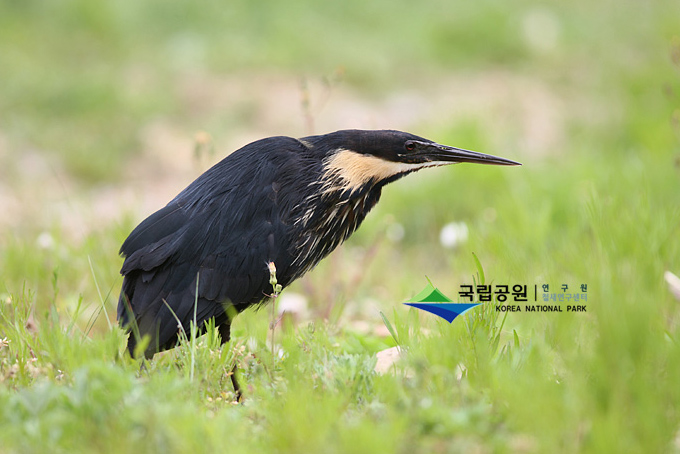
Japanese Night Heron Gorsachius goisagi  V1 Br:1
V1 Br:1
A rare migrant, with most records on offshore islands and near the coast. One recent breeding record. Recorded from March to November, but mostly in April and May. One photographed on Jeju Island on April 12th (KYH) preceded one at Taejeongdae Park, Busan City, on May 1st (KHG). One on Socheong Island, Incheon, was seen by multiple observers between May 18th and June 1st (NM), while another photographed on Mara Island, Jeju Island, on May 29th (JWRC) was approximately the 30th record for the ROK known to Birds Korea.

Striated Heron Butorides striata S3, WV2 Br:1
A common and widespread breeding summer visitor to all kinds of freshwater wetland, generally recorded from early-April to late November. The recent trend of overwintering on Jeju Island continued, with two at Seogwipo on February 4th and one on November 27th (MP). Overwintering was first recorded here in December 2008 (Gang et al., 2010).
Western Osprey Pandion haliaetus P4, W5
A passage migrant from mid-March to early June and again from late August to mid-November (when almost all records are of juveniles), and a local winter visitor, most regular in the Nakdong Estuary, Shinan County and on Jeju Island. One at the Nakdong Estuary, Busan on July 22nd (NM) is apparently the first national record for July.
Cinereous Vulture Aegypius monachus  W3, SV2
W3, SV2
A local winter visitor which is generally recorded from mid-November to mid-March, with occasional records into April and May, and some mid-summer records on Jeju Island. The vast majority of birds in the ROK are juveniles, with many reliant on artificial feeding centres which are subject to sudden closure in response to outbreaks and / or fear of avian influenza. A total of 1,084 were recorded nationwide by MOE (2010), compared with a peak count of 1,435 in 2005 (MOE 2005). In 2010 at least five individuals with individually-numbered wing-tags (placed by researchers in Mongolia) were recorded:
- No. 118, Cheorwon, Gangwon Province, January 3rd (KDH).
- No. 102, Jinju, Gyeongsangnam Province, January 15th (OGS).
- No. 106, apparently injured, was taken into care at Paju, Gyeonggi Province, in February. This individual was tagged at Ikh Hart Nature Reserve in Mongolia, c.1700km to the Northwest (BUG).
- No. 56, March 25th, Upo Wetland, Gyeongsangnam Province (UWES). This individual was first recorded in the ROK in December 2008, and again in March 2009 at Pyeongchang in Gangwon Province.
- No. 104, Goseong, Gyeongsangnam Province, December. This individual apparently returned for the second winter in a row to the same site (Jeong, 2010).
Greater Spotted Eagle Aquila clanga  P5, WV1
P5, WV1
A scarce passage migrant and winter visitor, typically recorded from early October to late February. One seen on Jeju Island on June 17th (KYH, RN) is an exceptional mid-summer record. Earlier on Jeju Island, one had been photographed on January 9th (JSB). Elsewhere, individuals were photographed overflying Weiyeon Island, Chungcheongnam Province, on October 10th (JJM); Gureop Island, Ongjin County, on October 23rd (IBA); and the Seosan Reclamation Area on November 8th (KSH).
Eastern Imperial Eagle Aquila heliaca  WV1
WV1
A rare migrant and winter visitor, most often recorded in less developed reclamation areas and on offshore islands. A juvenile was photographed in Haenam County on January 9th (HSW). One juvenile was photographed at Goseong County in Gyeongsangnam Province on November 20th (OGS)and at the Junam Reservoirs, a juvenile was seen between November 20th (JSB) and December 3rd (DLC, JL).
Golden Eagle Aquila chrysaetos W5, SV2 Br:3
A rare and local migrant and winter visitor, perhaps occasionally resident in suitable habitat In 2010, recorded from at least three locations:
- Cheorwon, Gangwon Province. An immature was seen on February 3rd (NM, DH, CH).
- Jeju Island: An adult was photographed on February 16th (KHM), followed by another adult on December 9th (JWRC).
- Paju, Gyeonggi Province. One immature was photographed on December 30th (KSHO).
Northern Goshawk Accipiter gentilis P3, W4, R5 Br:1
Breeding continued at the now-traditional site along the Namhan River in Chungju, Chungcheongbuk Province, where a pair and three nestlings were photographed on June 2nd (BJG). Breeding was also recorded at Seosan, Chungcheongnam Province, where at least one chick was photographed in June and again on July 26th (KSH).
Black Kite Milvus migrans W4, P5, R5 Br:1
A local resident in the southeast (apparently more numerous in winter), with small numbers found during migration along the west coast and on offshore islands and in winter on Baekryeong Island, Ongjin County. Based on visible migration research, some Black Kites have long been suspected of moving between Busan and Teima Island (Tsushima) 50km to the south. As the species was also known formerly to be a widespread Korean breeder but not in Busan (Duckworth & Moores 2007), it seems plausible that the “new” population in the southeast was derived from birds from Japan, where the species is still numerous. This hypothesis was supported in 2010 by the radio-tagging of, "Number 83202", caught and released at the Nakdong Estuary, Busan on February 22nd. This individual stayed in the area until October 13th. A month later, on November 13th, it had moved 66km southward to Tsushima Island, Japan, where it remained until at least January 2012 (Hur et al, 2011).
Steller's Sea Eagle Haliaeetus pelagicus VU W5
A rare and local winter visitor, though surprisingly easy to overlook at some sites, from November (earliest known to Birds Korea is one on November 15th 1999 in the Seosan Reclamation Area), to early or mid-March. Apparently regular at a very few sites.
In 2010 recorded from at least seven locations, involving up to 12 individuals:
- Han River, Paldang / Misari, Gyeonggi Province. Two adults were present and reported by multiple observers from January 3rd (JB) until at least February 15th (JB), when they were joined by a third. In the latter part of the year, one adult had appeared on November 27th (CSH), and was still present on December 4th (KJC).
- Jinju, Gyeongsangnam Province. Two immatures were photographed on January 15th (OGS).
- Yangyang, Gangwon Province. Two immatures seen on January 21st (NM, AS, CU, FW, GE) were still present on January 24th (TE, DLC, HH). One remained into February, being seen on the 6th (NM, DH, CH) and 21st (DLC, MW, SS).
- Gumi, Gyeongsangbuk Province. One immature was photographed on January 24th (OKS).
- Nakdong Estuary, Busan, Gyeongsangnam Province. One adult was seen on February 22nd (MW, SS).
- Yeonggi County, Chuncheongnam Province. One adult was photographed on December 29th (LSW).
- Gangneung, Gangwon Province. An immature was photographed at Gyeongpo Lake, Gangneung (Gangwon Province) on December 30th (HJH).
Grey-faced Buzzard Butastur indicus P2, S5 Br:1
At the now traditional site in Chungju, Chungcheongbuk Province, a pair raised three chicks (CEY, WIK). Breeding was also confirmed at Jombong Mountain, Inje, Gangwon Province, where an adult was photographed on June 26th (PHS) and a fledgling on July 18th (KJC).
Rough-legged Buzzard Buteo lagopus W5
Two subspecies are believed to occur in the ROK: regular menzbieri (only formally described as a subspecies in 1951) and much rarer kamtschatskensis (first-recognised in 1931, and the name given by Austin [1948] to all Rough-legged Buzzard in Korea). Field identification criteria of the two subspecies remain poorly known and presumably greatly complicated by individual variation. During a winter with multiple records of Rough-legged Buzzard (most tentatively ascribed to menzbieri), at least one - an adult male photographed at Siwha Reclamation Area on January 19th (JBS) and 21st (TE) - possessed multiple features said by Brazil (2009) to be shown by kamtschatskensis (i.e. hooded look, paler flank patches; reduced pale on the bases of the upper primaries; and broad white tips to the upperparts). Another photographed at the Seosan Reclamation Area on January 26th (LKG) also showed several features believed to be shown by this subspecies, followed by a sub-adult male photographed at the same location on November 28th (KSH) perhaps also tentatively ascribable to kamtschatskensis.
Eastern Buzzard Buteo japonicus P3, W3, SV2
One was radio-tagged by the National Institute of Biological Resources and its movements were logged through part of the year. "Number 83199" was fitted with a transmitter and released at Cheorwon, Gangwon Province on March 3rd. Its spring migration began on April 6th when it left the area and flew 1661 km in 18 days to Sovetskayagavan / Sovetskaya Gavan in the Sovetsko-Gavansky district of Khabarovsk Krai, Russia, where it spent the summer. Its southward migration began on October 10th, arriving back at Cheorwon 15 days later on October 25th (Hur et al, 2011).
Amur Falcon Falco amurensis P4
A scarce migrant, with passage concentrated through the northwest, from late April to late May and again from late September to late October. In 2010, there were reports from at least five locations on the mainland:
- Nakdong Estuary, Busan. Two were photographed on May 3rd (JMW).
- Gongreung Stream, Paju, Gyeonggi Province. Up to ten were present on September 28th (KHK). Small numbers of this species have been recorded every autumn in this area since at least 2006 (BDB).
- Seosan Reclamation Area, Chungcheongnam Province. In October, one was photographed on the 6th (KSH) and two were present on the 27th (CHS). One juvenile was photographed on the late date of November 7th (LSW).
- Yangyang, Gangwon Province. Six, including at least four juveniles, were photographed on October 30th (BH).
- Gangneung City, Gangwon Province. Fifty-eight, including juveniles, on November 1st (HJH) are apparently the first record of this species for Gangneung, a rare November record, and a notably large concentration.

Saker Falcon Falco cherrug  V1
V1
A rare migrant and winter visitor, increasingly recorded in recent years. One in the Seosan Reclamation Area from December 2nd until at least December 29th (KSH) is apparently the 13th national record.
Gyrfalcon Falco rusticolus V2
On March 20th one was photographed in flight, inland, in Sangju City on the Nakdong River in Gyeongsangbuk Province (Jin et al,, 2010). Although the identification is widely accepted as correct, the images are of poor quality and from below appear to show a largely unmarked raptor with irregularly dark primary tips and some faint barring on the tail. Expert advice is now being sought on this bird’s identification and age even though it is considered by many to be the first record of this species for Korea and has already (provisionally) been added to Category 1 of the Birds Korea Checklist. The inland location, date and plumage (presumably an adult or near-adult?) are all considered exceptional. Within the region, it is described as a rare but annual visitor to lowland, coastal Hokkaido, with dates from November 5th to March 15th, with the only record away from Hokkaido one in 1963 on Tsushima / Teima Island (Brazil 1991). The species apparently was used in falconry in north-eastern China in past decades.
Brown-cheeked Rail Rallus indicus W5
A scarce and easily overlooked winter visitor to shallow, heavily-vegetated freshwater habitats, recorded between mid-October and late April. In 2010, at least one was reported from the Seosan Reclamation Area between January 5th (SOHS) and January 13th (KUJ). At Ansan Reed Park in the upper reaches of Sihwa Reclamation Area, one was photographed by multiple observers between January 6th (CTH) and February (SHG), as was one or two at the Junam Reservoirs ( via Mo In Ho). In Jeollanam Province, one was photographed on Hong Island on April 25th (LWM) and one recorded on Heuksan Island in early November (KNPS, 2010). There was one also at Achasan, Seoul, on November 11th (HSM).
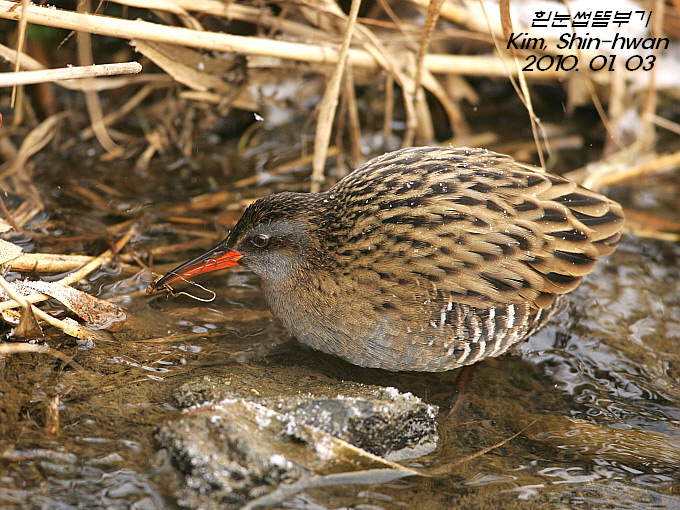
White-naped Crane Grus vipio VU W3, P3
A scarce and local winter visitor and passage migrant mostly at a handful of traditional sites, from early October to mid-April. Numbers of birds overwintering has increased in recent years, and MOE (2010 ) reported a total of 1,433 nationwide, compared with less than 650 each winter between 1999 and 2004. In Cheorwon (Gangwon Province), whch supports the largest concentrations of this species, one leg-banded individual No. "249" was seen on February 3rd (NM, DH, CH), and 150 were counted on February 28th (MW, SS, DLC, HH). The peak count at the Junam Reservoirs was also of 150 on February 8th (NM, CH, DH), with 66 present there the following winter by December 6th (DLC). Away from more regular sites, 25 were photographed on Geoje Island, Gyeongsangnam Province on January 17th (GET) and six were at the Nakdong Estuary, Busan on February 6th (JMW).
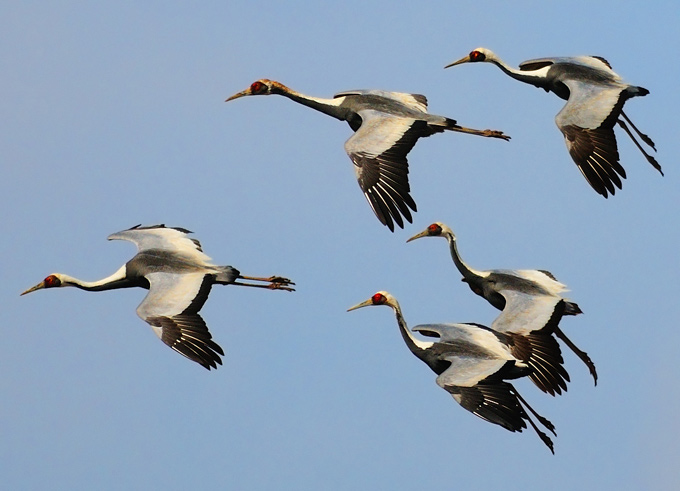
Red-crowned Crane Grus japonensis  W4
W4
A scarce and very local winter visitor, from early November to late March,.mostly near to the DMZ. A total of 1,051 were reported by MOE (2010) a slight increase on the number overwintering in 2009, and the largest number reported since the survey started in 1999 (when 382 were counted: MOE 1999).
Common Crane Grus grus V1
An annual winter visitor and perhaps passage migrant in very small numbers, recorded from late October to mid-March. Pure birds are apparently greatly outnumbered by various generations of suspected G. monacha X G. grus hybrids, while the movement of cranes between Suncheon and Seosan also complicates record-collecting. In 2010, apparently pure birds were reported from at least three sites:
- Cheorwon, Gangwon Province. One immature was noted on January 3rd (KWBS).
- Seosan Reclamation Area, Chungcheongnam Province. One apparently pure individual was accompanied by three hybrids on March 19th (LSS). In November, one with one hybrid were photographed on the 18th (PCW), with three pure individuals present from the 20th (ABS) until the 27th (BJS), with two still there on the 28th (KSH).
- Suncheon Bay, Jeollanam Province. MOE (2010) reported five between January 22nd and 24th. However, three pure birds accompanied by two apparent hybrids were earlier photographed on January 10th (ODP), with at least one pure bird still present on February 24th (MW, SS).
Hooded Crane Grus monacha  P3, W4
P3, W4
A local passage migrant and scarce winter visitor, generally recorded from late October to late April. Nationwide, 436 were recorded by MOE (2010) in January, an increase of almost a quarter from the year before and more than double the number that overwintered between 2004 and 2007. Much of this increase can be attributed to artificial feeding at Suncheon Bay, as well as generally milder winter temperatures in recent decades. Conversely, construction as part of the Four Rivers project destroyed much of the habitat in the major Hooded Crane staging area near Gumi, Nakdong River, and at the Namhan River in Yeoju, where 57 had been photographed on March 20th (CSK).
Yellow-legged Buttonquail Turnix tanki V1 Br:2
A rare and apparently rapidly-decreasing passage migrant, mostly recorded in May and again from early September to early November. Shy, elusive, and presumably much overlooked. A male was seen on Socheong Island, Incheon, on May 29th (NM). There are at least 30 previous records for the ROK.
Black-winged Stilt Himantopus himantopus P4, S5, WV2
During migration, 19 at Uiwang Reservoir, Gyeonggi Province, on April 5th (KHK) is the highest count for this inland site to date. This species has occurred at this site every spring since at least 2003. Local breeding (first noted in 1998) also continued in the Seosan Reclamation Area, where ten adults and at least one chick were photographed on July 11th (KSH). The recent trend of (attempted) overwintering also continued, with three photographed in the Saemangeum Reclamation Area on December 21st (PCS).
Pied Avocet Recurvirostra avosetta V1
A rare annual visitor, with records from mid-November to late June. In 2010, reported from at least four locations:
- Cheongcho Lake, Sokcho, Gangwon Province. One was photographed on March 31st (CMS).
- Namdae Stream, Yangyang, Gangwon Province. Two were present on March 27th (BH).
- Nakdong Estuary, Busan. One was present from at least March 27th (KBS) to April 4th (LGS).
- Jeju Island. Three were at Hado on March 19th (JSB, MP) and one was at Seongsan on May 9th (JSB).
Grey-headed Lapwing Vanellus cinereus V1
An annual visitor in very small numbers, most often recorded on offshore islands during northward migration. In May, one photographed on Gageo Island, Shinan County, on the 10th (TE) was followed by singles on Jeju Island on the 24th (KYH), Hong Island (Shinan County) on the 25th (KNPS, 2010) and Eocheong Island (Gunsan City) on the 30th (SKS). At Sihwa Reclamation Area, Ansan, one was present from June 11th (JJOG) to 14th (KJC).
Pacific Golden Plover Pluvialis fulva P4
An uncommon passage migrant generally recorded from early April to late May and again from early August to late October, exceptionally to late November. At Sacheon, Gyeongsangnam Province, 60 on September 27th had increased to 88 on October 1st (MF), the second-largest concentration recorded nationally known to Birds Korea.
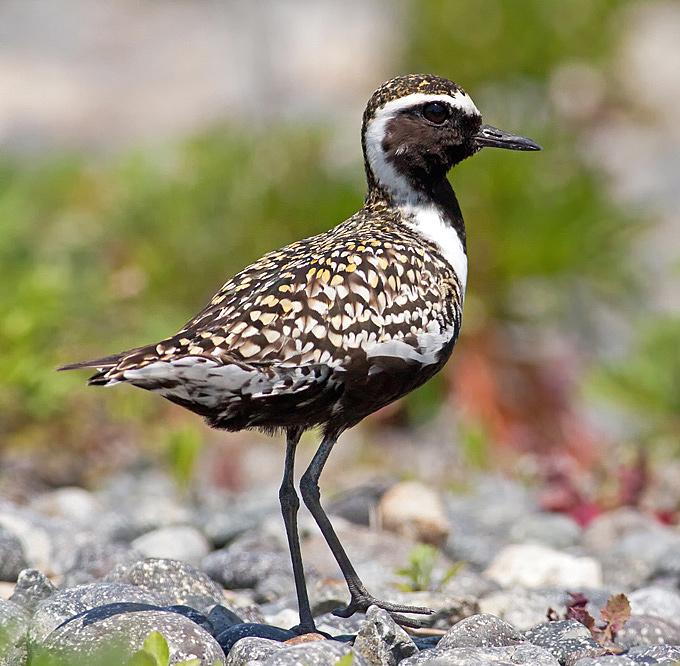
Common Ringed Plover Charadrius hiaticula V1
A rare passage migrant, annual in recent years, recorded from late March to mid-April and again from mid-August to early October. Three photographed at Gyeongpo Lake, Gangneung (Gangwon Province) on September 21st (CTH) is approximately the 21st national record since the first in 1962.
Greater Sand Plover Charadrius leschenaultii P5
A scarce migrant, from mid-April to late May, and early July to mid-October, recorded most regularly at the Nakdong and Geum estuaries. Away from those two areas, it was recorded from at least ten other locations:
- Eochong Island. One was seen on May 2nd(CSHN / Park et al, 2013).
- Socheong Island. One was photographed on May 8th (NM).
- Jeju Island. One at Pyoseon on August 12th (JWRC) was followed by one on September 8th (PHU).
- Namdae Stream, Gangneung (Gangwon Province).One photographed on August 14th (HJH) was probably the same individual still present on August 21st (LKG).
- Namyang Bay, Gyeonggi Province. Singles were photographed on August 16th (PHS) and August 28th (KJC).
- Jumunjin, Gangwon Province. One was photographed on August 29th (PHS).
- Dongjin Estuary, Saemangeum Reclamation Area. Three on September 4th (NM, JL).
- Gomso Bay, Jeollabuk Province. One on September 9th (NM, JYK).
- Gimje, Jeollabuk Province. One was photographed in October (LHC).
- Aphae Island, Jeollanam Province. One was photographed on October 7th (HDG).
Oriental Plover Charadrius veredus V1
A very scarce, annual migrant, through the south and west, with now annual records from late March to mid-May, and again less frequently from mid-August to early September. In 2010, recorded from at least five locations:
- Heuksan Island, Jeollanam Province. Three were photographed on April 3rd (PYW), with singles also present on April 7th and 8th (KNPS, 2010).
- Weiyeon Island, Chungcheongnam Province. Two were present on April 8th (JJM), where a male and one female were photographed on April 10th (KJM).
- Eocheong Island, Gunsan City. One in non-breeding plumage was photographed on April 13th (TE).
- Gageo Island, Jeollanam Province. Single adult females, possibly the same individual, were photographed on April 27th and 28th (TE) and seen on May 3rd (RN). An adult male was also photographed on May 10th (TE).
- Yubu Island, Geum Estuary. One was seen on September 7th (NM).
Greater Painted-snipe Rostratula benghalensis R5 Br:1
A rarely observed though probably much-overlooked species, with breeding confirmed at several mainland sites and also on Jeju Island (Gang et al, 2010).
Recorded this year from at least six locations:
- Gojang County, Jeollabuk Province. In January, one was photographed on the 1st (LHC) and two on the 10th (KSH). In April, a pair was seen on the 2nd (IKW) and 7th (PCS), and were photographed with four chicks on May 23rd (LDJ).
- Seosan Reclamation Area, Chungcheongnam Province. Two males seen on January 10th (KSH) were followed by a pair photographed on April 24th (JAL) and a female in July (KSH).
- Suncheon Bay, Jeollanam Province. A male was photographed on January 10th and 15th (HDG).
- Gyeongpo Lake, Gangneung, Gangwon Province.A female was photographed on June 14th, (HJH).
- Sihwa Reclamation Area, Gyeonggi Province. In September, an adult female was photographed on the 19th (KHJ), followed by possibly the same female with two juveniles on the 20th (JJOM), and accompanied by one juvenile on the 21st (ABS).
- Heuksan Island, Jeollanam Province. An immature female was banded and photographed on October 13th, and still present the following day (KNPS, 2010).

Pheasant-tailed Jacana Hydrophasianus chirurgus V1 Br:1
An increasingly reported summer visitor, this year reported from at least four locations:
- Ganseong, Goseong County, Gangwon Province. One was photographed on May 28th (PHW).
- Gyeongsangbuk Province. One non-breeding plumaged adult was photographed on May 29th (OKS).
- Jeju Island. One adult in breeding plumage was present from at least May 31st (JSB) to June 6th (PHW) and a juvenile was photographed on October 5th (JSB).
- Jeonju, Jeollabuk Province. At the Han Reservoir, a juvenile was seen from October 9th (CSK) to October 23rd (BJS).
Solitary Snipe Gallinago solitaria W5
A rare and local winter visitor (with an estimated population of 10: Moores 2006) and passage migrant, probably overlooked, generally from November to March (with extreme dates known to Birds Korea of October 30th and.March 21st). Away from the most well-known regular wintering site at the National Arboretum, Seoul, where e.g. four on January 20th (NM, AS, CU, FW, GE) and two on February 3rd (NM, DH, CH), one was also photographed in January at Gojang County, Jeollabuk Province, on the 12th (LDJ) and 13th (ODP).
Asian Dowitcher Limnodromus semipalmatus  PV1
PV1
A very scarce migrant, recorded typically in April and May and again from early August to late October. Reported annually in recent years. On Jeju Island, one photographed on March 15th (Park J-Y et al, 2013) is considered an exceptionally early record (note: the earliest found during formal survey work in Hong Kong in spring 2010 was between April 6th-8th: Anon 2010). This was followed by another, assuming breeding plumage, at Hado from April 28th (LDJ) to May 2nd (KJC). A non-breeding adult was then found on May 11th (KYH), and was still present on May 14th (JSB).At the Mangyeung Estuary, Saemangeum Reclamation Area, one was also seen on September 6th (NM, JYK) – approximately the 18th record for Korea.
Black-tailed Godwit Limosa limosa  P3, SV2, WV2
P3, SV2, WV2
A fast-declining passage migrant to coastal mudflats, shallow freshwater wetlands, ponds and rice fields. Two photographed in Gyeonggi Province on December 9th (LSS) are at least the sixth winter record since 2003. Based on observations in the ROK and elsewhere in the Yellow Sea, it seems probable that more than one Black-tailed Godwit taxon occurs in the ROK, with occasional much larger, longer-billed and somewhat paler individuals for now being ascribed to nominate limosa (see: http://www.birdskorea.org/Gallery/Species/BK-GA-Limosa-limosa.shtml). Observers are encouraged to record full details of larger birds or birds present in mid-winter.
Far Eastern Curlew Numenius madagascariensis  P3, S4, WV1
P3, S4, WV1
An internationally important count of 3,264 in September 2010 on tidal-flats between Yeongjong and Ganghwa islands (Incheon) is believed the largest concentration of this species in the ROK this year.
Little Whimbrel Numenius minutus P5
A scarce migrant, most often recorded on offshore islands, recorded mainly from mid-April to early May and much less often again from late August to early October. 2010 proved a remarkable year for this species, with an unprecedented number of reports, from at least seven locations:
- Socheong Island, Ongjin County. In April, 11 were seen on the 20th, followed by one on the 29th (NM).
- Gageo Island, Jeollanam Province. In April, one was seen on the 20th and 21st (RN), followed by singles on the 25th and 28th (TE).
- Hong Island, Jeollanam Province. In April probably the same individual was photographed on the 23rd (JSS) and 24th (CDJ).
- Heuksan Island, Jeollanam Province. One was photographed on April 24th (JJM).
- Mulleung, Jeju Island. In April, a flock of eleven had appeared by the 24th (JSB), with 38 counted on the 27th (LDJ). On May 1st, three small groups were flushed and merged to form a single flock of 40 individuals (MP, KYH) - a new national high day-count and double the previous record. On May 2nd, at least 17 remained (KJC). It is perhaps noteworthy that all records on Jeju Island to date have been in the southwest (Gang et. al., 2010).
- Weiyeon Island, Chungcheongnam Province. In May, three were photographed on the 1st (BJS) and at least two were present on the 5th (PHS).
- Seosan Reclamation Area, Chungcheongnam Province. Two photographed on September 23rd (CHS) are rare mainland (and autumn) records.

Spotted Redshank Tringa erythropus P4, W5
One at the Junam Reservoirs, Gyeongsangnam Province, on February 23rd (DLC, MW, SS, HH) and five at the Mangyeung Estuary, Saemangeum Reclamation Area on February 26th (ODP) are presumably early migrants. The species used to be regular in winter at least in the Haenam area in the late 1990s / early 2000s (NM), and was also considered a “common spring and autumn migrant” by Austin (1948) with the first flocks arriving back in the Suwon area, near Seoul, by March 15th in 1946.
Nordmann's Greenshank Tringa guttifer  P5
P5
A rare migrant, recorded from mid April to mid-May, and again from late August to mid-October. In 2010 reported from at least five sites, involving probably c.30 individuals, with all records in September (presumably because of poor coverage in other months):
- Cheonsu Bay, Chungcheongnam Province. Singles were photographed on the 5th (KSH), 9th (CHS) and 19th (KSH), followed by two on the 23rd (CSHN,Park et al, 2013).
- Dongjin Estuary, Saemangeum Reclamation area, Jeollabuk Province. Four were seen on the 5th (NM, JYK, JL).
- Mangyeung Estuary, Saemangeum Reclamation Area, Jeollabuk Province. Three on the 5th; ten, including five juveniles, on the 8th (NM, JYK); and further singles on the 24th (ODP) and 27th (CSHN).
- Geum Estuary, Jeollabuk Province. Two on the 6th were followed by one on the 7th and another on the 8th (NM, JYK).
- Namyang Bay, Gyeonggi Province. Three were photographed on the 6th (PHS) and the same number seen on the 10th (NM, JYK); at least seven were counted on the 23rd (SKS) and one was still present on the 26th (PHS).

Great Knot Calidris tenuirostris  P2
P2
A formerly locally abundant and now generally uncommon passage migrant, recorded from late March to late May, and again from early July to early November. Internationally important counts on remaining tidal-flats in the outer part of Namyang Bay included at least 2,000 on March 28th (RN, IKW) and 5,800 on September 10th (NM, JYK).
Red-necked Stint Calidris ruficollis P2, WV2
A fairly widespread passage migrant, most regularly recorded from mid-April to late May and again from late July to early November. Highest counts included 4,759 within the Saemangeum Reclamation Area between September 4th and 8th, and 1,390 within the main Asan Bay Reclamation Area (Gyeonggi Province) on the 10th (NM, JYK).
Little Stint Calidris minuta V1
A rare but presumably much-overlooked migrant recorded from mid-April to mid-May and again from late July to late September. One photographed at Gangneung, Gangwon Province, and seen by multiple observers from September 5th (HJH) to 11th (SIS) is apparently the 13th national record known to Birds Korea.
Spoon-billed Sandpiper Eurynorhynchus pygmeus  P5
P5
A rare and rapidly declining migrant, with most records from mid-April to late May (when peak numbers have been recorded: Moores 2012), and again from earlyAugust to mid-October. Due to a general lack of coverage, all sightings relate to September, when reported from four locations, involving up to 17 individuals:
- Yubu Island, Geum Estuary, Jeollabuk Province. Four seen on the 7th (NM, JYK) were followed by two on the 18th (PJH), both of which were still present on the 26th (ABS, KJC, BJS).
- Saemangeum Reclamation Area, Jeollabuk Province. Three were photographed on the 4th, and one was seen on the 5th (NM, JYK, JL).
- Gomso Bay, Jeollabuk Province. Four or five juveniles were seen (and photographed) on the 9th (NM, JYK), the first record of this species at this site.
- Jeju Island. One was photographed on the 16th and possibly the same individual was seen again on the 24th (PHU,Park J-Y et al, 2013).
Buff-breasted Sandpiper Tryngites subruficollis  V2
V2
A juvenile photographed in the Saemangeum Reclamation Area on September 23rd (JYG) is the second national record.

Red Phalarope Phalaropus fulicarius V1
A scarce but probably much-overlooked migrant, most regular in open sea areas. One photographed close to shore on the Guryongpo Peninsula, Gyeongsangbuk Province, on January 23rd (NM, AS, CU, FW, GE) is apparently the first fully-documented midwinter record.

Oriental Pratincole Glareola maldivarum P5, WV2 Br:2
An uncommon, passage migrant generally recorded from mid-April to early June and in lesser numbers southward, from mid-July to early October. A recently-fledged juvenile photographed at Mokpo, Jeollanam Province, on July 2nd (KSY) suggests local breeding. There are two previous suspected breeding records nationally, from 2004 and 2008.
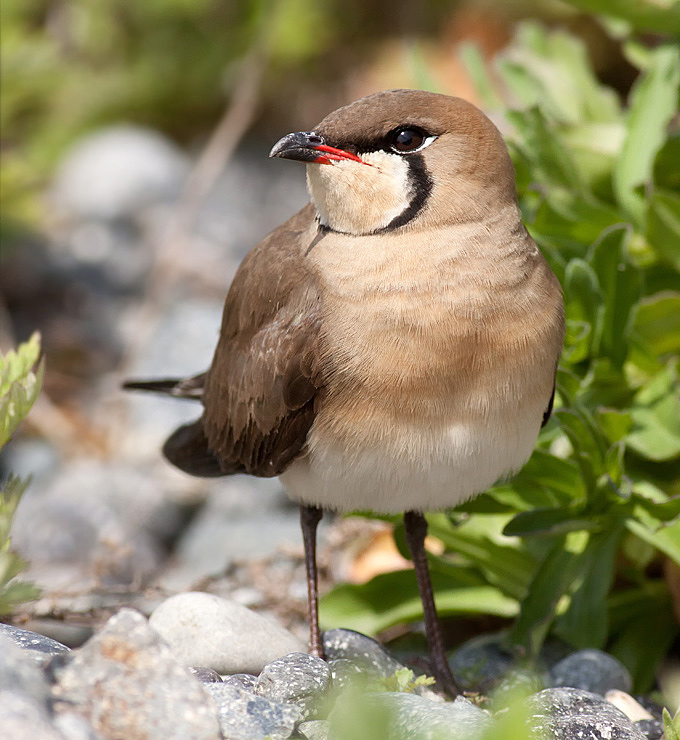
Saunders's Gull Chroicocephalus saundersi W3, P3, S4 Br:1
A rare and local breeding species and a rather more widespread and numerous winter visitor to intertidal areas. A total of 1,294 were recorded nationwide in January by MOE (2010). At Song Do (Incheon), where at least 100 were counted on February 15th (TE, DLC), the breeding colony was seen to be active on June 10th, and 25 adults were seen feeding 16 fledglings on July 20th (TE). On September 8th, 22 (including one juvenile) were at the Geum Estuary (NM, JYK), suggesting local breeding. Internationally important mid-winter counts included 360 at Namyang Bay (Gyeonggi Province) on February 1st (JBS) - where 187 were also counted on March 1st (SIS).
Relict Gull Ichthyaetus relictus  W5
W5
An increasingly rare winter visitor, with records since 2000 spanning from early October to mid-March. At Namdang Village, Hongseong County, Chungcheongnam Province, two were photographed between at least January 26th (LKG) and February 24th (LSS), with one remaining until March 7th (BJS).At Namyang Bay, Gyeonggi Province, in February, singles photographed on the 1st (JBS) and 19th (PHS) were followed by five there on March 1st (SIS).
Glaucous Gull Larus hyperboreus W4, SV2
A local winter visitor, typically seen from late October to mid-March. One photographed at Buan, Jeollanam Province on April 11th (LGH) is rather late and also an unusual record on the west coast.
Iceland Gull Larus glaucoides WV1
A rare winter visitor to the east coast, recorded from early November to early March. Many of the records are of birds that do not appear to fit well with descriptions / expectations of nominate glaucoides. One, such bird was photographed at Guryongpo, Gyeongsangbuk Province, on January 23rd (NM, AS, CU, FW, GE). It was longer billed than typical nominate glaucoides, with perhaps more pale grey in the spread wing.
• Mongolian Gull Larus mongolicus P2, W3, S4 Br:1
Mainland breeding continued at Song Do, Incheon, where 18 nests and 43 individuals were counted on April 19th, rising to 20 nests by April 26th (SBI). On June 10th, there were at least 21 adults and 21 chicks present (TE). Elsewhere, a small breeding colony was noted on the Seonyan islets, near Gureop Island (Incheon), on June 25th (NM, TE).
Caspian Gull Larus cachinnans V2
Although identification remains tentative due to lack of certainty over the appearance of eastern cachinnans and the lack of taxonomic consensus, this taxon is increasingly claimed in the ROK. If identification is correct, this species appears to be a rare but perhaps annual winter visitor, primarily to the east coast, recorded from mid-December to early May. One possible photographed on Gageo Island, Jeollanam Province, on January 12th (NM) was followed by another photographed at the Guryongpo Peninsula, Gyeongsangbuk Province, on January 23rd (NM, AS, CU, FW, GE). One at Daejin Harbour, Gosong County (Gangwon Province) first noted and photographed on February 5th (NM) was still present on February 20th (TE, RN, DLC, MW, SS). The latter individual is likely the same as one in exactly the same location the previous winter.
Steppe Gull Larus (heuglini ) barabensis V1
If identification criteria are correct, apparently a very scarce winter visitor. One photographed just outside of the Seosan Reclamation Area, Chungcheongnam Province on February 7th (NM, CH, DH) was in the exact same location as a sub-adult photographed there in March 2005.
Sooty Tern Onychoprion fuscatus V1
A rare, overshooting migrant, recorded from mid-June to early September. Two together seen within the Saemangeum Reclamation Area, Jeollabuk Province, on September 5th (NM) is only the sixth record known to Birds Korea.
Common Tern Sterna hirundo P2, SV2
A locally numerous passage migrant, especially in May and September, both along the east coast and in open sea areas of the West Sea. In recent years, with an increase in observer activity, this species has become increasingly noted in the mid-summer months too. Up to 300 terns seen off Ganseong, Gangwon Province, on June 28th were judged to be mostly of this species (BH), and one was also photographed at Mokpo (Jeollanam Province) on July 12th (KSY). In addition, one minussensis was photographed at the Seosan Reclamation Area in July (KSH) - the fifth record of this subspecies in the ROK known to Birds Korea.
Whiskered Tern Chlidonias hybrida P5, WV1
A scarce but increasingly-recorded species, peaking in number during the main migration periods (April-May, August-October), with additional records throughout the year. Most notable records included two on Heuksan Island, Jeollanam Province, on April 27th-28th, and three on April 29th- with one remaining until May 2nd (KNPS, 2010). These are perhaps the first records for that island. Two on Gageo Island, also in Jeollanam Province, from April 28th-29th (TE) are also likely the first recorded there too. Twenty in, or close to, the Geum Estuary (Chungcheongnam Province) on June 13th (KJC) – appears to be the largest summertime flock yet recorded. These were followed by two inland at the Junam Reservoirs on June 19th (DLC), several off Ganseong (Gangwon Province) from June 23rd-28th (BH), and one at Yeongrang Lake, Sokcho (Gangwon Province), on June 23rd (CMS).
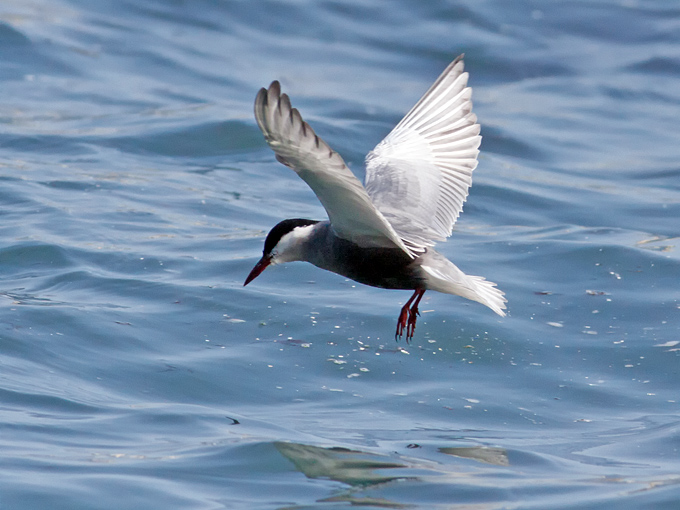
White-winged Tern Chlidonias leucopterus P4
An uncommon migrant, most numerous in autumn. Two photographed in the Seosan Reclamation Area on June 6th to 13th (KJC) are very late (or very early!) migrants and the first mid-summer records of this species known to Birds Korea. Elsewhere, a flock of 19 over the sea between Incheon and Socheong Island on May 24th (TE) was the highest count of the year known to Birds Korea.
Long-tailed Jaeger Stercorarius longicaudus V2 (Cat.3).
One seen (but not photographed) between Heuksan and Gageo Islands (Jeollanam Province) on April 17th (RN) was followed by another near Mara Island, Jeju Special Autonomous Province, on June 13th (Kim H-J et al, 2010). There are several previous sight-records of this species – in the southwest, west and southeast - but due to lack of adequate documentation (i.e. a photograph or specimen) this species remains in Category Three of the Birds Korea Checklist.Based on observations from Japan (NM), this species likely moves through the Korean Straits during migration, occasionally in large numbers.
Little Auk Alle alle V2 (Cat.3)
One tiny non-breeding plumaged black and white alcid seen flying from a fast-moving ferry between Incheon Port and Socheong Island (Incheon) was considered to be this species; and one similarly tiny breeding-plumaged alcid seen approximately 400km to the south, on January 9th, from the ferry between Mokpo and Gageo Island (Jeollanam Province), was also identified as Little Auk (Moores 2012). The latter individual was seen at close range to the boat, sitting on the sea, and was all black above, with black head and breast, and contrasting white flanks. No images could be taken of either individual, but views were sufficient to rule out all other alcids and to add this species to Category 3 of the Birds Korea Checklist. These sightings also recall a tiny, unidentified alcid seen near Socheong Island on December 11th 2007 (RN) that also possibly refers to this species. This species is known to be pelagic in winter and has formerly strayed as far south as Japan and even Okinawa (Brazil 2009).
Brunnich's Murre Uria lomvia W5
A very scarce winter visitor mostly to open sea in the north-east, increasingly recorded in recent years. In January one was close inshore to Ulleung Island, Gyeongsangbuk Province, on the 18th (OKS), and one was off Okgye, Gangwon Province, on the 22nd (NM, AS, CU, FW, GE). In February, two were seen off Geojin, Gangwon Province, on the 20th (TE, RN, DLC, MW, SS).
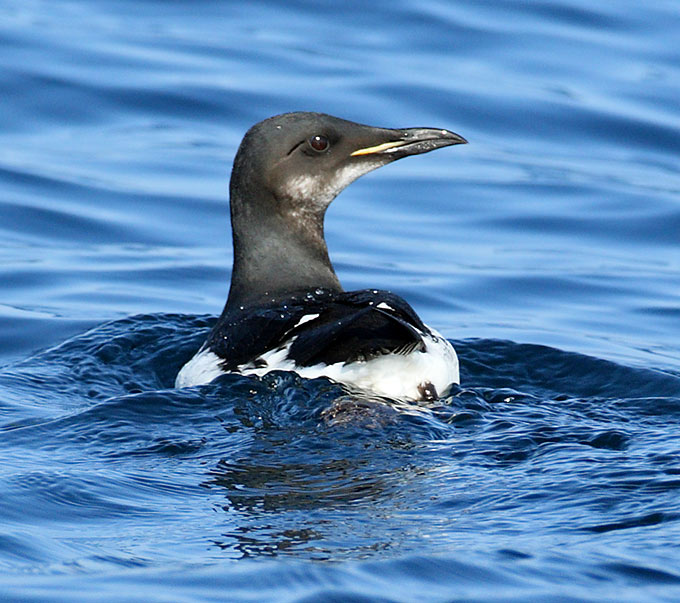
Common Murre Uria aalge W5
Recorded annually since at least 2004. At Jangsa harbour, Sokcho, Gangwon Province in January, two were photographed on the 10th (JSS), and one was still present on the 25th (TE). One seen off Heuksan Island (Jeollanam Province) on November 29th (KNPS, 2010) is the southernmost record to date, and apparently the first Korean record away from the East Sea.
Spectacled Guillemot Cepphus carbo W5
A scarce and local winter visitor to coastal Gangwon Province as far south as Yangyang, recorded annually in recent years, mostly between early January and early March. Four seen off Daejin on January 22nd (NM, AS, CU, FW, GE) were followed by eight in the same area and toward Geojin on February 5th (NM, CH, DH), where also three on February 20th (TE, RN, DLC, MW, SS) and two on February 21st (RN, TE).
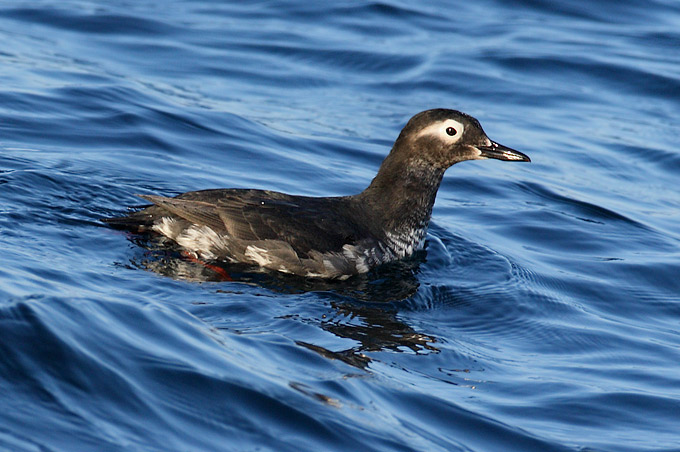
Long-billed Murrelet Brachyramphus perdix  W5
W5
A scarce and easy to overlook winter visitor to the east coast and less frequently to the Yellow Sea. It is found most regularly from early December to early March, with records annually since at least 2005. One seen off the Guryongpo Peninsula (Gyeongsangbuk Province) on January 23rd (NM, AS, CU, FW, GE) was followed in February by three between Daejin and Geojin (Gangwon Province) on the 5th (NM), three “possibles” off Gageo Island (Jeollanam Province) on the 20th (NM) and one or two off the Guryongpo Peninsula on the 25th and 26th (MW, SS).
Ancient Murrelet Synthliboramphus antiquus W2, S4 Br:1
A common but decreasing breeder and winter visitor (Moores 2012), which has become rather scarcer in recent winters. Largest concentrations this century have been found along the East Coast between early November and March. A recent study has found this species to be the primary casualty of coastal fisheries. The survey of 31 ports from Goseong County to Donghae City along the east coast, from November 2008 to February 2009, found 962 drowned as by-catch (Park et. al, 2009). This study however recorded only those birds that were brought ashore and could be found: it did not estimate the number discarded at sea.
Rhinoceros Auklet Cerorhinca monocerata W3
A locally common winter visitor to the east coast, from late November to early March. It is rarely recorded south of the Guryongpo Peninsula, and there appears to be only one record for Jeju Island, involving one off Hanlim-eup in December 1987 (Gang et al, 2010). One seen 1-2km north of Heuksan Island on January 15th (NM) is the first record for the ROK part of the Yellow Sea since several were seen from and near Socheong Island, Incheon, in December 2003 (Moores 2007). Of note, Tomek (1999) details several summer records from islands off the west coast of the DPRK and suspects that breeding is / was probable there.
Black Wood Pigeon Columba janthina  R4 Br:1
R4 Br:1
A very local species of mostly offshore islands, found regularly from islands off Jeju in the southwest to Ulleung and Dok islands in the east. Monthly survey of Gageo Island, Jeollanam Province, in 2009 and early 2010 confirmed that birds were resident on the island while rapid survey on other islands also found this species present in mid-summer on Heuksan and Hatei Islands. The research by Birds Korea suggests that the species “appears to be strongly limited by human disturbance” on Gageo and these other southwestern islands (Birds Korea 2010).
Eurasian Collared Dove Streptopelia decaocto V1
One photographed on Deunchido near the Nakdong Estuary, Busan on February 21st (KSHW) was followed by another seen on Socheong Island, Incheon, on May 19th (NM) with presumably the same individual then photographed there on May 29th (NM, TE). These are the eighth and ninth records of this species this century.
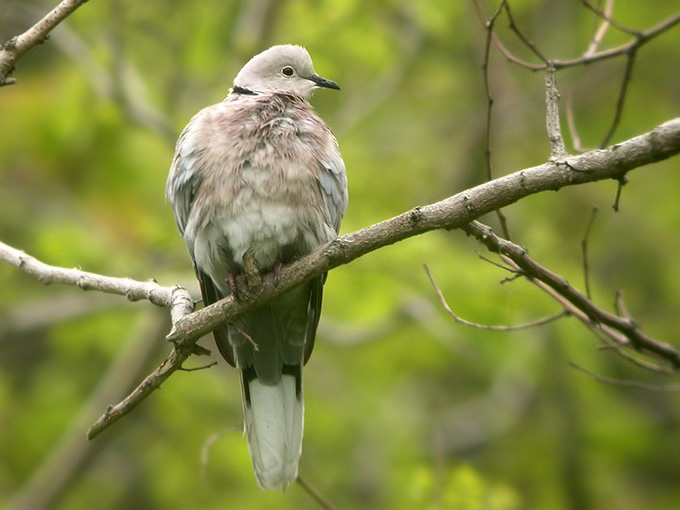
White-bellied Green Pigeon Treron sieboldii V1
A rare visitor usually seen in winter and spring in the far south, recorded annually since 2004. A female was present in the Halla Arboretum, Jeju Special Autonomous Province, from January (MP, KYH) to at least April 3rd (JSB). A male was photographed in Gangjin County, Jeollanam Province on March 13th (LDJ).
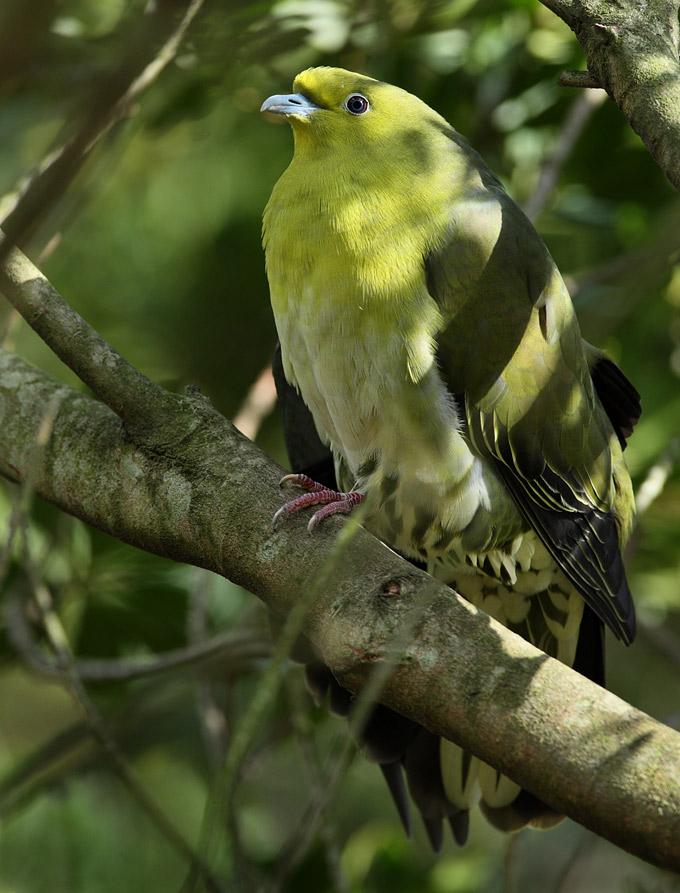
Greater Coucal Centropus sinensis V2 (Cat.4)
A probable was seen on Eocheong Island (Jeollabuk Province) on May 17th (AP). There is only one earlier sight record: one seen at close range in flight on Socheong Island (Incheon) in May 2006.
Lesser Coucal Centropus bengalensis V2
One photographed on Jeju Island on June 6th (KHC) is Korea's third record.
Asian Koel Eudynamys scolopaceus V2
One heard on Socheong Island, Incheon, on May 28th (NM) is approximately the third national record.
Large Hawk-Cuckoo Hierococcyx sparverioides V2
On Socheong Island (Incheon), one heard on May 19th (NM) was followed by another seen well there on May 27th (NM, TE). There are now seven records for this species, all from the offshore islands of Gageo and Socheong, all between late April and late May.
Ural Owl Strix uralensis R5 Br:1
A rarely-recorded species of forested uplands of Gangwon and Gyeonggi Provinces, apparently prone to wider dispersal in winter. An adult with one fledgling photographed at Pocheon, Gyeonggi Province, on August 15th (CEY) is only the second fully documented record of breeding, after the first in 2007.
Little Owl Athene noctua V1 Br:1
A rare visitor, mostly found in winter, recorded annually since 2004, and with one record of breeding. In 2010 recorded from at least four locations:
- Cheorwon, Gangwon Province. One was photographed on January 3rd (LSI).
- Okku, Gunsan City, Jeollabuk Province. One was photographed and seen by multiple observers from January 3rd (ODP) until at least January 26th (LDJ). This is apparently the southernmost record on the mainland since one seen near the Dongjin Estuary on January 17th 2002 (NM).
- Chungcheongnam Province. One was photographed on January 10th (KJC).
- Kongreung Stream, Paju, Gyeonggi Province. One was seen and photographed by multiple observers from September 26th (JDM) to at least October 17th (JJOM).
Himalayan Swiftlet Aerodramus brevirostris V1
A rare offshore migrant. One was seen over Hong Island, Jeollanam Province, in early May (KNPS, 2010). There are approximately 17 previous records known to Birds Korea, with most records from mid-April to early June.
Common Swift Apus apus V2 (Cat.3).
One “possible” seen over Socheong Island on May 16th (NM) – when all-dark upperparts noted - is the sixth national sight record since 2001. This species has still yet to be adequately documented however with an image.
Common Kingfisher Alcedo atthis S3, R5 Br:1
On Eocheong Island, Gunsan, the sudden appearance of nine, all perched on the same harbour wall, on April 17th (TE) seems noteworthy. This species is not usually noted for migrating in flocks.
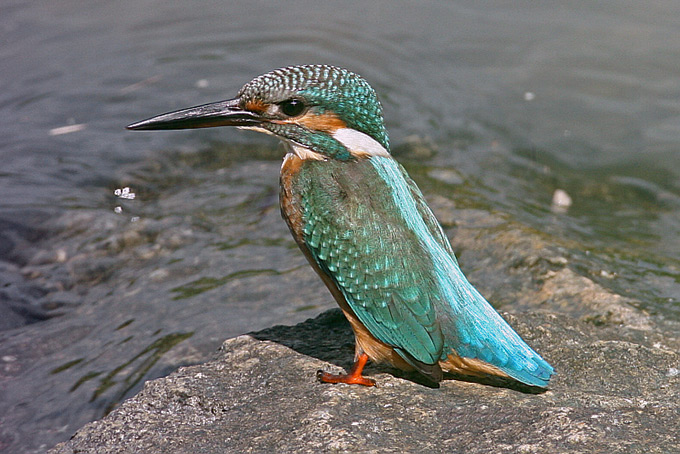
Crested Kingfisher Megaceryle lugubris V2 (Cat.2)
In Paju, Gyeonggi Province, an (anonymous) local birdwatcher claimed to have seen one in December, although no photograph was taken, and repeated follow-up visits to the site failed to find anything (SKS). This species has not been recorded in the ROK since a specimen was found / purchased on February 13th 1949 (Park 2002).
Eurasian Wryneck Jynx torquilla P4, WV2
An uncommon passage migrant, most frequent on offshore islands and along the west coast of the mainland, mainly recorded from mid-April to early May and late August to late October. Twenty-eight on Socheong Island, Incheon, on April 29th (NM) is a new national high day-count of this species.
Rufous-bellied Woodpecker Dendrocopos hyperythrus PV1
A rare but probably overlooked migrant, with records from mid-April to late May and again from mid-September to October. On Socheong Island, Incheon, in May, singles were seen on the 8th and the 25th (NM). The latter is approximately the 14th record for the ROK known to Birds Korea.
Grey-capped Pygmy Woodpecker Dendrocopos canicapillus R5 Br:1
Formerly common (at least in Gyeonggi and Gangwon provinces), now a scarce but apparently gradually recovering resident. Although some of the recent increase in records might be because of increased observer activity, some also seems likely due to the gradual maturation of forest, much of which was re-planted in the 1960s and subsequently. At the now traditional sites, up to two were observed at the Gwangneung National Arboretum (Seoul) from January 20th (NM, AS, CU, FW, GE) to March 11th (RN,CN), where one had reappeared by December 11th (IKW). At Sahmyook University in Seoul one was photographed on January 7th (SCG), and at Paju, Gyeonggi Province, a pair was photographed on December 26th (PJG). This species was also reported from two additional sites in 2010. At Guri, Gyeonggi Province, one was photographed on January 24th (KJC), and one was photographed in Muju County, Jeollanam Province on April 4th (LDJ).
Fairy Pitta Pitta nympha  S5 Br:1
S5 Br:1
A scarce and local breeding summer visitor, preferring dark broadleaved evergreen forest such as found in the southern coastal zone, yet also tolerating mixed woodland further north. On Geoje Island (Gyeongsangnam Province) one was photographed on May 25th, in an area where one had been heard in 2009. Continued monitoring of this same area into early July found at least four individuals (GET). On Socheong Island (Incheon) one was photographed on May 29th (TE), and possibly the same individual was also heard on June 1st and 2nd (NM). This is only the second (and perhaps third) record for that island after one in 2004. Individuals were also photographed at Seosan on June 6th (KSH), in Dongdaemun-Gu, Seoul on June 10th (CSK); at Mount Shikjang, Daejeon on June 15th (LSW) - where a regular breeder (HC); and Gapyeong in Gyeonggi Province (WIK). At a site within the Busan Metropolitan City area, where first seen in May 2009, a pair raised six chicks (BHK).

Black-winged Cuckooshrike Coracina melaschistos V2
One photographed on Eocheong Island (Gunsan) on May 15th (AP, TEK) was followed by another photographed on Socheong Island (Incheon) by (NM) on May 31st. These are the first photographic records of this species in Korea. There are about five previous sight records.
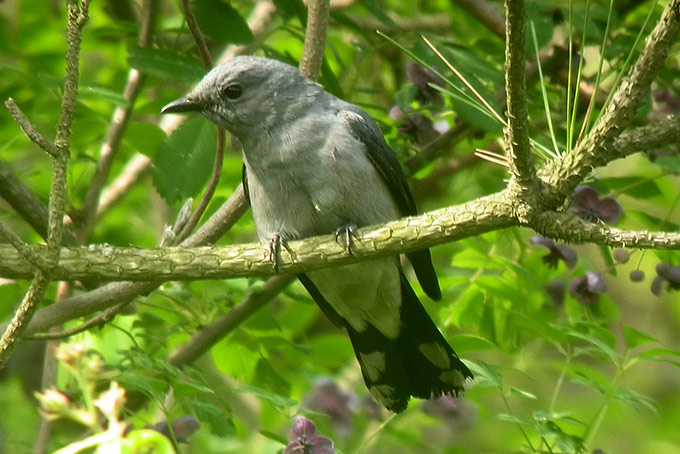
Brown Shrike Lanius cristatus P3, S5 Br:1
Formerly a common summer visitor, now a rare and irregular breeding summer visitor, and an uncommon, passage migrant mostly to offhsore islands, recorded from late April to early October. On Socheong Island (Incheon), 62 were counted on May 20th and 95 on May 25th (NM). The latter is a new national high day-count of this species, at least as part of formal survey. In addition, one confusus with white wing-patch and longer primary projection was photographed, also on Socheong Island, on May 21st (NM). Similar atypical individuals have been observed on passage through the ROK since at least 2004.
Long-tailed Shrike Lanius schach P5, WV1, SV2
A very scarce species, most often reported during main migration periods but also increasingly found overwintering and oversummering. Very small numbers may now be resident. Records include:
- Junam Reservoirs, Gyeongsangnam Province. One present since November 26th 2009 remained on site and was regularly seen by multiple observers until at least March 7th (DLC).
- Gageo Island, Jeollanam Province. Individuals were seen on January 10th (NM) and April 22nd (RN).
- Heuksan Island, Jeollanam Province. One seen on March 5th remained into early April. Another was photographed on August 20th, and a further individual was seen from September 25th until the end of the year at least.
- Jeju Island. One seen on April 3rd (MP, RN, KYH) was followed by one on October 30th (KHM).
- Socheong Island, Incheon. Possibly two different individuals were seen on April 7th and 8th (NM).
- Eocheong Island, Gunsan. Presumably the same individual was seen on April 11th and 12th (TE).
- Sihwa Reclamation Area, Gyeonggi Province. One was photographed on April 15th (OSH).
Black Drongo Dicrurus macrocercus P5
A generally scarce overshooting migrant recorded from late April to early June. There is also at least one July record - from Jeju Island (Gang et al, 2010). Rare in the autumn, primarily on Jeju Island, from mid-August to mid-November. Recorded on several offshore islands during the spring in 2010, with a high day-count of five on Socheong (on May 30th and June 1st: NM). One photographed at Seosan (Chungcheongnam Province on May 26th (CHS) is a rare mainland record. Singles photographed at Gyeongpo Lake, Gangneung (Gangwon Province) on June 2nd and Okgye, Gangwon Province on June 4th (SHS) are apparently the first records for the east coast.
Ashy Drongo Dicrurus leucophaeus V1
A rare overshooting offshore migrant, recorded from early to mid-May and in the autumn from late September to October. One photographed on Mungap Island, Incheon, between May 5th and 7th (JSS) is the ninth record for the ROK known to Birds Korea.
Asian Paradise Flycatcher Terpsiphone paradisi V1 Br:3
One seen on Socheong Island, Incheon, on May 18th (NM). Its assumption of breeding in the past in the ROK (in Moores & Kim 2013) appears to be in error and will be amended in the next Checklist update.
Black Paradise Flycatcher Terpsiphone. atrocaudata  S4, P5 Br:1
S4, P5 Br:1
An uncommon summer visitor to Jeju Island and to a number of sites on the mainland, and also a scarce migrant through through the southeast and offshore islands, recorded from late April to late September. Considred likely to increase by Moores (2012). A survey of Jeju Island found a total of 124 individuals in 2010, all between 83m and 1106m above sea-level, with most concentrated at around 500m a.s.l. The highest breeding density was in Dongbaekdongsan Gotjawal Forest, being eight times higher than in the similar Gotjawal Forest area- attributed to the presence of more ponds and streams. This report warns that such habitat is being lost to infrastructural development in the forest and its wetlands, and that the birds are also threatened by unregulated bird photography and eco-tourism (Kim et al, 2010). Presumed breeding away from Jeju included observations of one or two on Weiyeon Island (Boryeong City) on June 29th (NM) and a pair seen regularly through May and June on Geoje Island, Gyeongsangnam Province (GET). On the mainland too, a male was photographed in Gwangju Metropolitan City, on June 11th (HSW). Breeding was photographed in Daejeon Metropolitan City between June 19th and June 29th (LSW) and also at Dobisan, Seosan, Chungcheongnam Province, on July 20th (KSH).
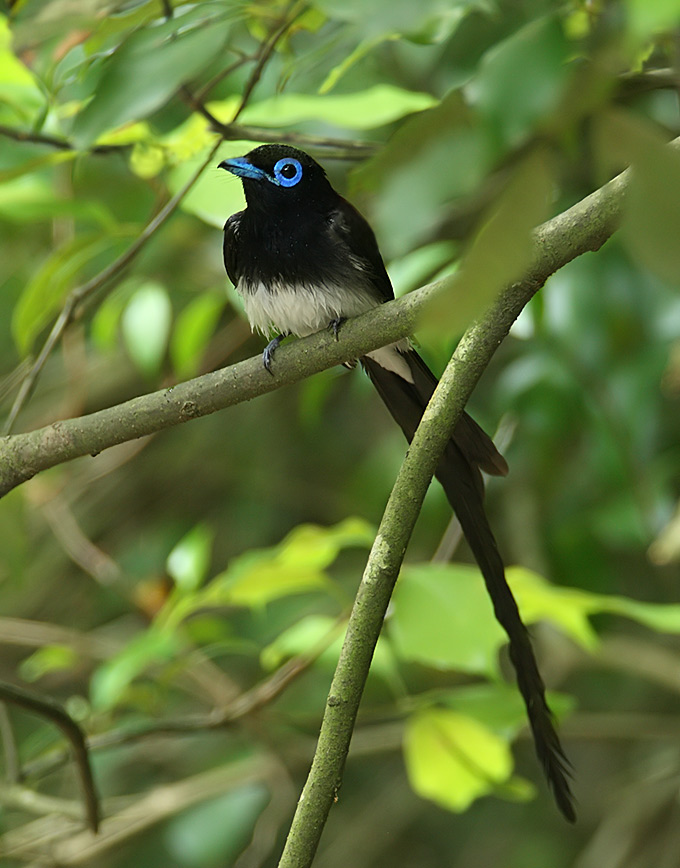
Eurasian Magpie Pica pica R1 Br:1
One seen on Hong Island, Jeollanam Province, on April 27th only (KNPS, 2010) was followed by one on nearby Gageo Island from at least May 13th - 20th (TE). This is believed to be the first record for Gageo Island.
Daurian Jackdaw Coloeus dauuricus P4, W4
A local winter visitor and passage migrant, from late October to late March, rather more numerous some winters than others. In 2010, only 1,512 were recorded nationwide by MOE (2010), a third of the number found in 2009 and less than a fifth of the number recorded in 2007 (MOE 2007, 2009). This species is usually found mixed in with much larger Rook Corvus frugilegus flocks. Noteworthy counts this year included 150 at Gyeongju, Gyeongsangbuk Province on January 23rd (NM, AS, CU, FW, GE) and two flocks totalling 300 at Ganseong, Gangwon Province on March 25th (BH).
House Crow Corvus splendens V2
One found on Mungap Island, Ongjin County, Incheon, by KWBS members on May 7th is the first record for Korea. It was seen -and fed- by multiple observers with last photographs publicly posted of the species known to Birds Korea on September 25th (JGT, IBA). Given the proximity of the island to busy shipping lanes and Incheon Port, it seems likely that this individual was ship-assisted.
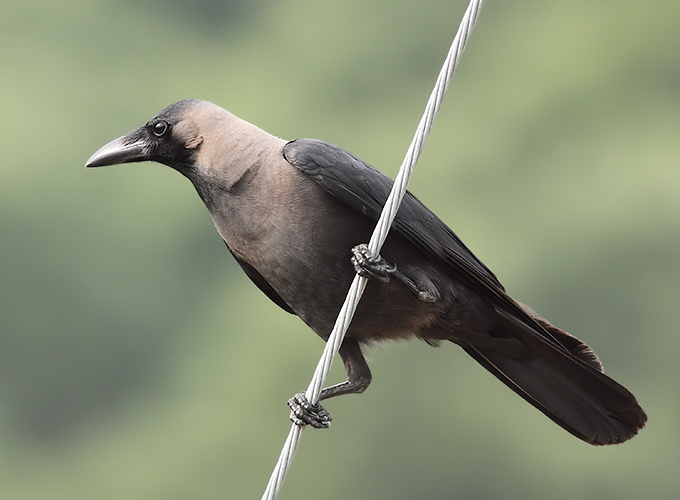
Rook Corvus frugilegus W2, P2
A passage migrant and local winter visitor, sometimes in huge concentrations. The commonest crow recorded by MOE (2010), with 50,922 recorded nationwide including 37,170 at the Taehwa River, Ulsan, Gyeongsangnam Province.
Japanese Waxwing Bombycilla japonica  W4, P4
W4, P4
A scarce passage migrant and irruptive winter visitor, typically recorded from December to May. In March a flock of 35 was at the Junam Reservoirs (Gyeongsangnam Province) on the 28th (DLC), with at least five photographed at Yeomak, Busan on the 31st (LGS). In April at least ten were at Hanam (Gyeonggi Province) on April 4th (KHJ), followed by two at Ansan City on the 8th (JJOM) and four still at the Junam Reservoirs on the 9th (DLC). Lastly one was seen on Socheong Island, Incheon, on May 8th (NM).
One photographed and banded on Heuksan Island, Jeollanam Province, on November 18th (KNPS 2010) is an unusually early arrival date.
Yellow-bellied Tit Periparus venustulus P5, WV1 Br:2
A very scarce migrant and winter visitor, increasingly reported since the first national record in 2005. In 2010 recorded from at least five locations:
- Dongbaek Islet, Busan. Three which had been present since December 2009 continued to be photographed by multiple observers until at least February 28th (JJOM), and were rumored to have nested locally
- Seosan City, Chungcheongnam Province. One male was photographed on February 28th and again on March 6th (LKG, LHW). This was followed by a female photographed on October 14th (CHS).
- Weiyeon Island, Chungcheongnam Province. Two were reported on April 25th (LHW).
- Socheong Island, Incheon. Recorded on four dates during the spring, with two on April 24th, seven on April 25th, three on May 2nd and one on May 8th (NM).
- Achasan, Seoul. A female photographed on November 28th (HSM) remained into December (YHS).
Greater Short-toed Lark Calandrella brachydactyla P4
An uncommon, primarily spring migrant through southern and western islands, mostly recorded from early April to late May. In 2010, encountered in higher numbers at several sites than in previous years. Thirteen on Socheong Island, Incheon, on April 16th (NM) is a high count for that island; 10 on Eocheong Island (Gunsan) on April 17th (TE) is likewise perhaps a high count for there; and a flock of 25 on Gageo Island (Jeollanam Province) on the 27th (TE) is apparently a new national high day-count. On the mainland, where rarely reported, one photographed at Gyeongpo Lake, Gangneung (Gangwon Province) on May 5th (HJH) is only the second record for the east coast known to Birds Korea.
Asian Short-toed Lark Calandrella cheleensis V2
A rare visitor recorded in spring, autumn, and winter. One photographed on Weiyeon Island (Boryeong City) from April 2nd-3rd (PHS) was followed soon after by one photographed on Socheong Island (Incheon) from April 3rd-4th (NM). The latter is considered by Birds Korea to be only about the 11th national record. The status code will therefore be amended from V2 to V1 in the next Checklist update..
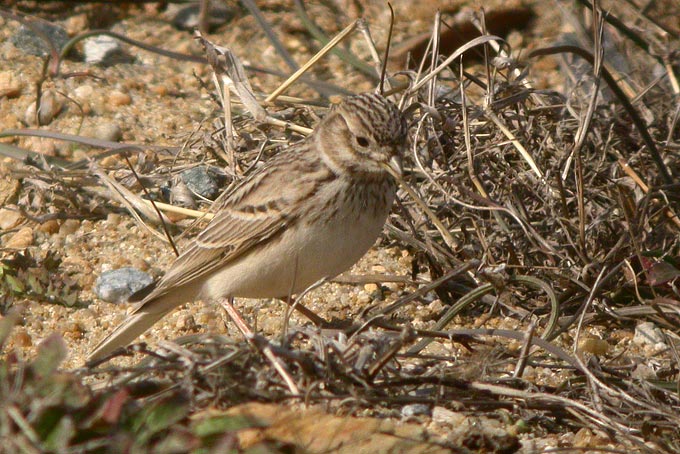
Light-vented Bulbul Pycnonotus sinensis P5, S5, R5 Br:1
First recorded in 2002; by 2010 a scarce migrant (most numerous in May) and rare, local breeder on offshore islands in the West Sea, with very small numbers resident in the far south. In 2010, recorded from at least seven locations:
- Gageo Island, Jeollanam Province. Four on January 10th (NM). In April, singles were noted on the18th (RN) and 29th (TE). Two were also seen almost daily between May 9th and 20th (TE).
- Junam Reservoirs, Gyeongsangnam Province. One heard on February 8th (NM, DH, CH) is apparently the first inland record. All previous mainland sightings have been at coastal sites.
- Hong Island, Jeollanam Province. One or two were present from March 3rd to 13th (KNPS, 2010). One was photographed by KWBS members on April 25th, and singles were recorded into May (KNPS, 2010).
- Socheong Island, Incheon. None found in February, with only one present on March 31st. In April, one on the 2nd was followed by one or two on the 6th and singles seen on multiple dates throughout the month. In May, an apparently resident male was joined by a female on the 16th; then five were counted on the 18th and eight on the 25th (NM), increasing to 15 on May 29th (NM) - amongst the highest day-counts of this species in the ROK to date. Breeding was again suggested with the observation of six, including four juveniles, on September 20th (SKS).
- Eocheong Island, Gunsan City. One was seen on May 21st (RN).
- Dokjeok Island, Ongjin County, Incheon. Three were seen on May 21st (DLC, HH).
- Mungap Island, Ongjin County, Incheon. Two were photographed on May 21st (GCS, OTS). This is a new site for the species.
Pale Martin Riparia diluta V2
One or two intriguing brown martins, presumed to be of this species (showing e.g. a shallow tail notch and extremely pale coloration) were seen on Socheong Island, Incheon, on May 24th and 25th (NM, TE).
Barn Swallow Hirundo rustica P1, S2, WV2 Br:1
Formerly abundant, and now in prologed decline (Moores 2012). Six on Jeju Island on February 15th (MP) is perhaps the first national record for that month since overwintering was attempted in the early 2000s (most recently in 2004).
Eurasian Crag Martin Ptyonoprogne rupestris V2
A rare spring visitor. One seen over Dokjeok Island, Incheon, on May 21st (DLC, HH) is only the sixth record for Korea.
Common House Martin Delichon urbicum P5
The taxon lagopodum is a scarce migrant, primarily through offshore islands, recorded annually since the first confirmed record in 2003. Generally occurrs from early April to late May, and again from mid-September to mid-October. In April, one was seen on Socheong Island, Incheon, on the 20th (NM) followed by one photographed over Weiyeon Island, Boryeong City, on the 30th (LHW). On Socheong Island in May, 11 on the 25th is the highest national day-count. At least four were still present there on the 26th (NM, TE).
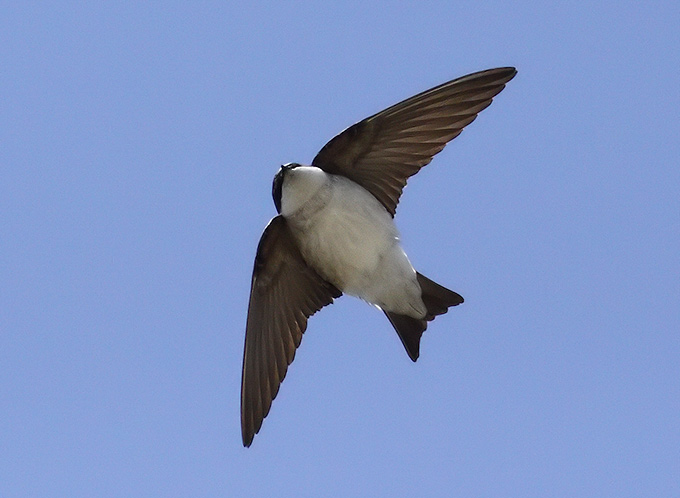
Korean Bush Warbler Horornis borealis P3, S4, WV2 Br:1
A fairly common migrant and breeding summer visitor northwards, generally recorded from mid-April to late October. In the spring, 24 on Eochong Island on April 17th (TE) was a noteworthy arrival. In the summer, this species was found in territory on Dokjeok, Mungap and Beka islands in Ongjin County from June 24-27th (NM, TE). Lastly one seen on Gageo Island, Jeollanam Province, on January 12th (NM) is the first national record for January, and only thethird or fourth winter record.
Asian Stubtail Urosphena squameiceps P2, S3 Br:1
A common passage migrant and breeding summer visitor, generally recorded from mid-April to early October. On April 17th an arrival was recorded on both Eocheong and Socheong islands. On Eocheong Island (Gunsan City), 81 were counted (with probably many more in areas that were not surveyed); this number had apparently dwindled to 37 on the 18th and 26 on the 19th (TE). On Socheong Island (Incheon), an initial influx was similarly noted on the 17th, when 52 were counted. This was followed by a much larger arrival on April 29th when a count of the whole island found a total of 464 (Moores 2012) – a new national high day-count.
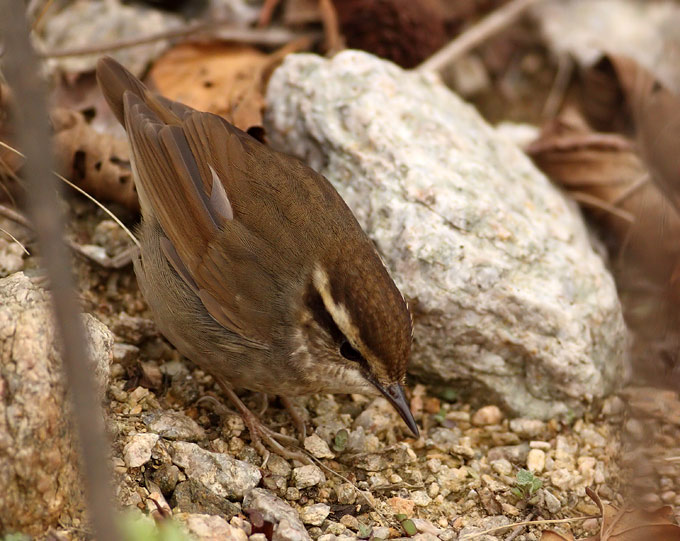
Long-tailed Tit Aegithalos caudatus R1 Br:1
White-headed caudatus is an irruptive winter visitor, apparently absent some years, generally recorded from mid-October to late March in Gyeonggi and Gangwon Provinces. There is at least one midsummer record from Gangwon Province. Reports for 2010 included one photographed on Heuksan Island, Jeollanam Province, on May 11th (LYI); one photographed in the “Seoul forest” from October 15th (YHS) to 27th (OSH); and one at the Sihwha Reclamation Area (Gyeonggi Province) on November 28th (JJOM). Of interest, one or two presumed caudatus / magnus intergrades, showing greatly reduced dark crown stripes on an otherwise white head, were seen on Beka Island, Ongjin County (Incheon) on June 26th (NM). Intergrades have been claimed before close to the 38th Parallel (Park Jin Young pers. com. to NM in 2000).
Common Chiffchaff Phylloscopus collybita V1
Since the first national record in 2004, tristis has been recorded near-annually during migration and more rarely still in mid-winter. One photographed and banded on Heuksan Island, Jeollanam province, on November 3rd is the eighth record for the ROK (KNPS, 2010).
Dusky Warbler Phylloscopus f. fuscatus P3, S5, WV1 Br:1
A common migrant through offshore islands, most numerous towards the northwest, with some breeding in the northeast and occasional birds overwintering, especially in the southwest. During northward migration on Socheong Island (Incheon), was first recorded on April 7th and last on June 2nd (when survey work was finished), with a peak day count of 96 on May 20th (presumed to be a new national high day-count) (Moores 2012). Two seen on Gageo Island, Jeollanam Province, on January 10th (NM) and one photographed in Gangjin County, Jeollanam Province, on December 18th (LDJ) continue the recent trend of overwintering.
Alpine Leaf Warbler Phylloscopus occisinensis V2
A rare, overshooting migrant to West Sea Islands in May. Formerly considered part of Tickell's Leaf Warbler Phylloscopus affinis, Alpine Leaf Warbler is a recent split (Martens 2010). Alpine Leaf often shows some orangey wash on the throat and breast (matching images taken in the ROK), and is also more obviously migratory, and is therefore considered to be the only of the two species likely to occur in Korea. One (seen well, description received) on Eocheong Island, Gunsan City, on May 11th (AP, TEK) becomes the sixth Korean record.
Pallas's Leaf Warbler Phylloscopus proregulus P3, S5, WV2 Br:1
One seen on Gageo Island, Jeollanam Province, on January 12th (NM) continues the recent trend of occasional overwintering in the southern coastal zone.
Yellow-browed Warbler Phylloscopus inornatus P2, WV2
A common migrant, generally recorded from late April to mid-May and again from late September to early November. An estimated 2,500 departing Socheong Island (Incheon) on April 28th (NM) is a new single-spot high count of this species. Numbers on the whole island on this date were believed probably similar or perhaps greater than the several thousand logged on Gageo Island, Jeollanam Province, on October 7th 2002.
Hume's Leaf Warbler Phylloscopus humei P5
A scarce offshore migrant, recorded in 2010 from five locations:
- Socheong Island, Incheon. Recorded on 13 dates between the first on April 24th and the last on May 31st, with a day high-count of two (on May 16th) and a total of probably 12 individuals (NM).
- Mungap Island, Incheon. One was photographed on May 8th (JSS).
- Eocheong Island, Gunsan City. One was photographed on May 9th (SKS).
- Gageo Island, Jeollanam Province. One was seen on May 12th (TE).
- Weiyeon Island, Boryeong City, Chungcheongnam Province. One was photographed on May 28th (PHS).
Arctic Warbler Phylloscopus borealis DD / P3
Following Alström et al. (2011), Arctic Warbler sensu lato is now recognised as three species: Arctic Warbler P. borealis, Kamchatka Leaf Warbler P. examinandus and Japanese Leaf Warbler P. xanthodryas. All three species have recognizably-different calls and songs and appear to show subtle plumage and structural differences too. All observers are encouraged to note details of calls and songs and to take recordings or images in order to help improve understanding of the status of these species in the ROK. In 2010, on Socheong Island, Incheon, Arctic Warbler sensu lato was first recorded on May 16th, with a day high-count of 197 on May 27th (Moores 2012). Based on sound recordings, both Arctic Warbler and Kamchatka Leaf Warbler were present at least on May 26th.
Sakhalin Leaf Warbler Phylloscopus borealoides V1
On Hong Island, Jeollanam Province, one was photographed and banded on April 25th, and three were logged from May 11th to 15th. One was also claimed on Heuksan Island, Jeollanam Province, on September 13th (KNPS, 2010).
Claudia's Leaf Warbler Phylloscopus claudiae V2
One heard briefly in song on Socheong Island, Incheon, on April 25th (NM) is the second record for Korea.
Black-browed Reed Warbler Acrocephalus bistrigiceps P3, S5 Br:1
A locally common migrant, especially northwards, with small numbers breeding in the northeast. Generally recorded from mid-May to mid-October. On Socheong Island, Incheon, first noted on May 18th, with the highest day-count 42 on May 29th, and birds still present at the end of survey on June 2nd (Moores 2012). In Gangwon Province, where a local breeding summer visitor, singing individuals were seen at Ganseong on June 10th and Yangyang on June 22nd (BH). In addition one seen and heard singing on Mungap Island, Incheon, on June 25th (NM, TE) was perhaps a late migrant.
Manchurian Reed Warbler Acrocephalus tangorum  V2
V2
Rarely recorded in May and October. One seen on Socheong Island, Incheon, on May 18th (NM) is apparently the fifth Korean record.
Thick-billed Warbler Iduna aedon P4
A scarce and local migrant through West Sea Islands, recorded from mid to late May and late August to early October. On Socheong Island, Incheon, first recorded on May 20th with 24 on May 30th (Moores 2012) a new national high day-count. In the southwest, where much scarcer, four were on Gageo Island, Jeollanam Province, on May 19th (TE).
Baikal Bush Warbler Locustella davidi V1
Extremely skulking and easy to overlook, generally revealed by its insect-like song. Perhaps occurs regularly in the northwest in late May during northward migration and more rarely during southward migration. On Socheong Island, Incheon, noted only on May 29th and 30th, with a peak of three on the 29th (TE, NM).
Lanceolated Warbler Locustella lanceolata P3
An uncommon, mostly offshore migrant, primarily through the northwest, generally recorded from mid-May to early June and again from late August to late October. One photographed at Uiwang Reservoir, Gyeonggi Province, on May 28th (JSS) and one at Sihwa Reclamation Area, also Gyeonggi Province, on September 4th (KJC) are scarce mainland records. All recent mainland records known to Birds Korea are from Gyeonggi Province.
Styan's Grasshopper Warbler Locustella pleskei  S3, P4 Br:1
S3, P4 Br:1
A scarce and local breeding summer visitor, mostly to offshore islands, with the greatest concentration on islands off Jeju and in Jeollanam Province. Birds Korea’s survey of this species in 2009 and 2010, visiting several West Sea islands, found none in Incheon in 2010 and only one on Weiyeon Island, Boryeong City, on June 29th. This island would seem to lie at the present northern limit of its breeding range (Birds Korea 2010). Further south, the highest density was found on Hatei Island, Jeollanam Province, where 41 or 42 territories were found in July, all associated with bamboo. However, within the Nakdong Estuary, Busan Metropolitan City, four or five territories were noted in only one stretch of reeds (NM).
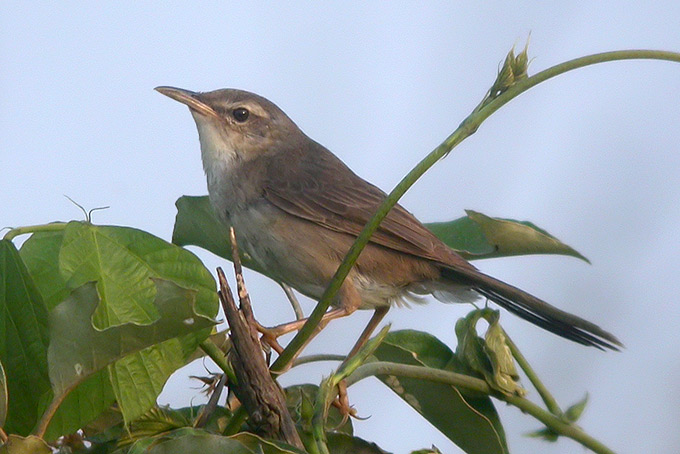
Pallas's Grasshopper Warbler Locustella certhiola P4
An uncommon passage migrant from mid-May to early June and again from mid-August to early October. In Gyeonggi Province, one photographed at Suwon on May 26th (KJC) and in the Sihwa Reclamation Area on September 4th (KJC) are rare mainland records.
Gray's Grasshopper Warbler Locustella fasciolataP4
A scarce and apparently declining offshore passage migrant from late May to early June and again from late August to early October. Identification is complicated by the recent recognistion of Locustella aminicola as a full species (see below). On Socheong Island, Incheon, recorded on seven dates during northward migration, with the first on May 18th and the last on June 2nd (the last day of survey), and the highest day-count being six or seven, on May 30th and 31st (Moores 2012). Elsewhere, one was photographed on Weiyeon Island, Boryeong City, on May 28th (PHS). One was also banded on Hong Island, Jeollanam Province, on September 14th (KNPS, 2010).
Sakhalin Grasshopper Warbler Locustella amnicola V2 (Cat. 6).
Split from Locustella fasciolata in 2012, and reviewed here for the first time as some of the Gray’s Grasshopper Warbler sensu lato are believed to refer to this taxon, based on differences in plumage and size first noticed in the early 2000s. However there are as yet no Korean records of this species that have been confirmed by banding or by sound recordings, and apart from the song, which is only subtly different from that of L. fasciolata, published information on how to identify the species (e.g. in Kennerley & Pearson 2010) still remains somewhat unclear or even contradictory. Nonetheless, in 2010 one or more probables were seen on Socheong on May 30th (NM, TE). One which was seen well (and photographed extremely poorly) running on the road, lacked any olive tones to the upperparts and had deep orange-buff on the vent and brown underparts (NM).
Chestnut-flanked White-eye Zosterops erythropleurus P3
An occasionally common migrant, especially through offshore islands in the west and northwest, with highest numbers associated with wind-drift during northward migration (Moores 2012). On Socheong Island, Incheon, in 2010, one of the most numerous landbirds during the period of northward migration, being recorded on 17 dates, with the first on May 7th and the last on June 2nd (the last day of survey), with the highest day count 335 on May 25th. (Moores 2012).
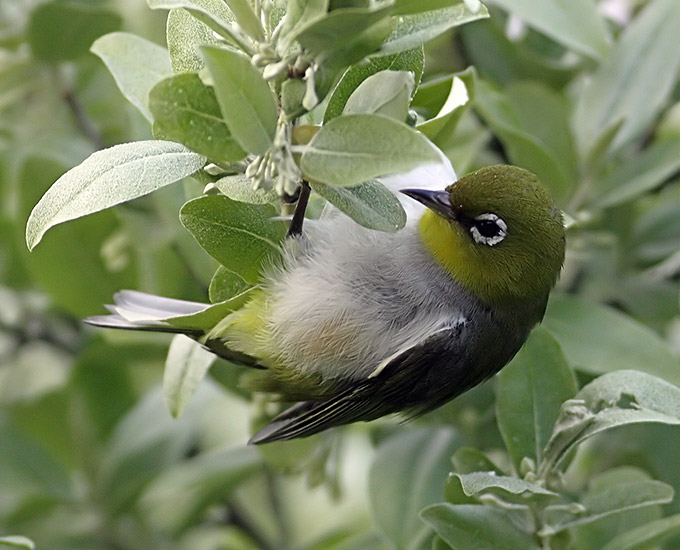
Japanese White-eye Zosterops japonicus R2 Br:1
A count of 148 nominate japonicus on Gageo Island, Jeollanam Province, on January 10th provides a useful indication of local numbers (NM). One seen on Beka Island, Incheon, on June 26th provides further evidence of a northward spread (with the species first found breeding in Namhansan, Seoul, in recent years: SKS pers. comm., 2013).
Simplex is an apparently scarce but regular passage migrant recorded in small numbers from late April to early June and again from mid-October to mid-November. On Socheong Island, Incheon, during northward migration, all Japanese White-eye seen well were simplex, with several photographed. Birds were recorded on 11 dates, with the first on May 1st and the last on 20th, with a peak day-count of 50 (in the east of the island only) on May 8th (NM). One was also photographed in the hand on Hong Island, Jeollanam Province, on May 11th (KNPS, 2010).
Chinese Nuthatch Sitta villosa WV1
An irregular and irruptive winter visitor, recorded from early October to mid-May; more frequently northwards. In some years, very few or no records. In 2010, records known to Birds Korea are limited to four at Daebo, near Geojin (Gangwon Province) on January 22nd (NM, AS, CU, FW, GE), where also one on January 24th (TE, DLC, HH) and three on February 5th (NM); and one on Socheong Island, Incheon, on January 29th (NM).
Red-billed Starling Spodiopsar sericeus P4, S5, W5 Br:1
This species continues to expand its range in the ROK since the first record in 2000. In addition to records on offshore islands (most during northward migration) it is now apparently present year-round, in varying numbers on Jeju Island (Gang et al, 2010). In addition, a pair photographed at the nest in Jumunjin, Gangwon Province (HJH) is at least the fourth area where breeding has been recorded, since the first in 2007 (Choi et al. 2011). In addition, one photographed at Uiwang Reservoir, Gyeonggi Province, from January 13th to February 26th (KHK, JB) appears to be the first record of overwintering for this province (although it has previously been recorded in mid-winter on Ganghwa Island, Incheon).
Daurian Starling Agropsar sturninus P4, SV1 Br:1
A generally scarce migrant, recorded from mid-April to early June and again from mid-August to mid-October, with very few recent breeding records. An adult male seen on Eocheong Island, Gunsan, on April 10th (TE) is unusually early. An adult female seen and photographed at Yangyang, Gangwon Province on June 22nd (BH) is a scarce midsummer record.
Orange-headed Thrush Geokichla citrina V2
On Socheong Island, Incheon, one probable seen on May 27th (NM) was followed by one photographed c.1km to the west on May 31st (NM, TE), remaining until at least June 1st. This is the second national record, after the first in 2004.
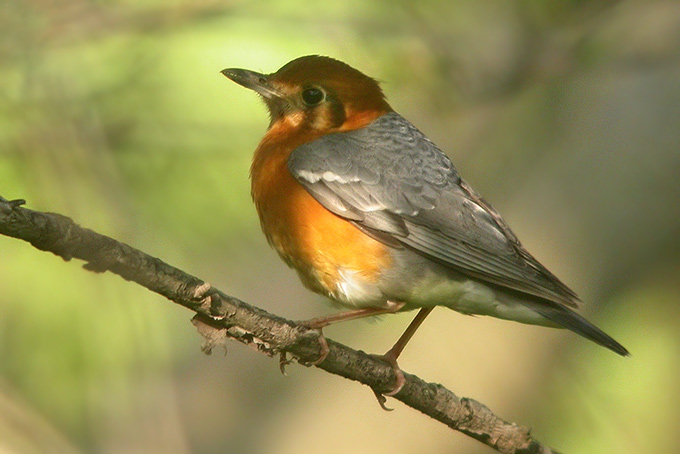
Grey-backed Thrush Turdus hortulorum P2, S3, WV2 Br:1
A locally numerous, mostly offshore passage migrant. Also a widespread and fairly common breeding summer visitor, generally recorded from early April to early November. During northward miigration on Socheong Island, Incheon, recorded on 48 dates, with the first on April 2nd and birds still present until June 2nd, the last day of survey (Moores 2012). An exceptional 652 on Socheong Island on April 29th (NM)is a new national high day-count.
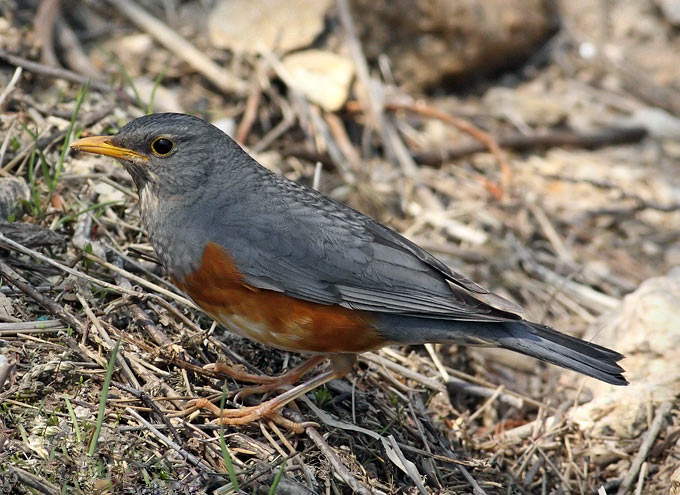
Eyebrowed Thrush Turdus obscurus P2
A locally common migrant, mainly through offshore islands from early April to late May and again from late September to mid-November. During northward migration on Socheong Island, Incheon, recorded on 36 dates, with the first on Aril 21st and the last on June 2nd (during the last day of survey). The highest day-count was 785 on May 8th (Moores 2012), even though only half the island was survyed on this date. Further south, 201 were seen on Gageo Island on May 12th (TE).
Brown-headed Thrush Turdus chrysolaus P4
An adult male orii photographed on Socheong Island, Incheon, on April 19th (NM) is the first Korean record of this subspecies.
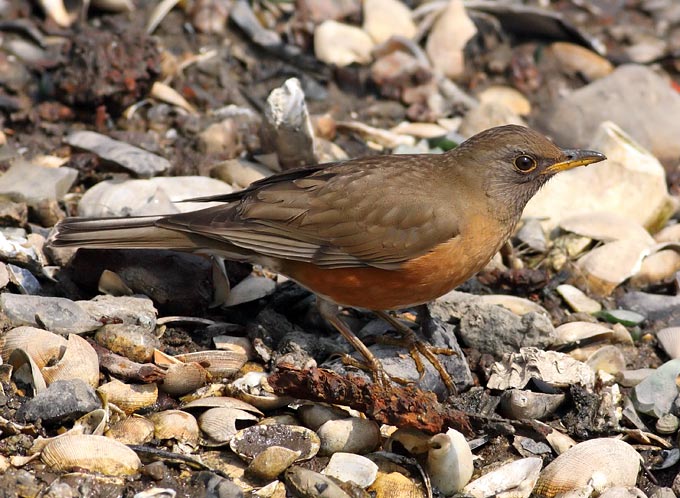
Black-throated Thrush Turdus atrogularisV1
One Second calendar-year male photographed on Socheong Island, Incheon, on May 2nd (NM) appears to be the only record for 2010.
Red-throated Thrush Turdus ruficollis P5, WV1
A scarce migrant and winter visitor. Observations commenced with an adult male photographed in Gyeonggi Province on January 16th (LSS) followed by a presumed First-winter at Yangyang, Gangwon Province, on February 6th (NM, DH, CH). In April, one was on Socheong Island, Incheon, on the 3rd (NM), while an adult male was photographed at Misari, Hanam City (near Seoul) from the 14th (KJC) to at least the 19th (LDJ). In addition, a possible Red-throated X Black-throated Thrush T. atrogularis hybrid was photographed on Hong Island, Jeollanam Province, on the 24th (LWM).
Rufous-tailed Robin Luscinia sibilans P3
A generally uncommon passage migrant, from early April to mid-May and again from late September to late October. On Gageo Island, Jeollanam Province, 148 on May 12th (TE) is a new national high day-count.
Red-flanked Bluetail Tarsiger cyanurus P1, W4
A common passage migrant; scarce during the winter. During northward migration on Socheong Island, Incheon, recorded on 42 dates, with the first on March 30th, the last on May 27th and the highest day-count 247 on April 17th (Moores 2012).
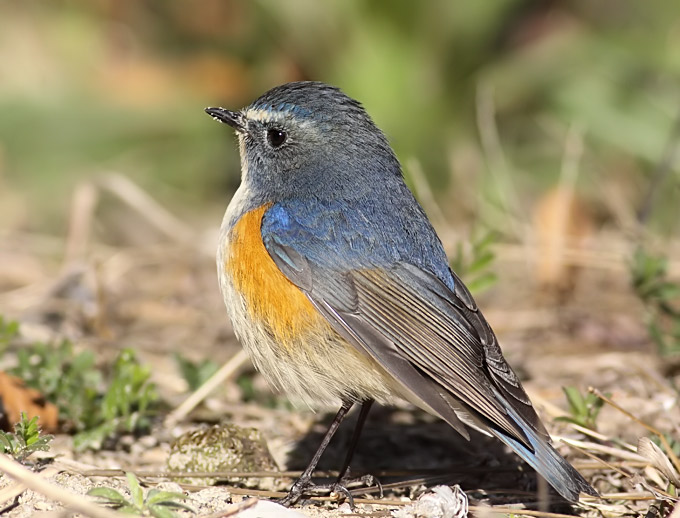
Black Redstart Phoenicurus ochruros PV1
An increasingly-recorded spring overshoot. In 2010, probably 17 individuals reported from at least nine locations:
- Heuksan Island, Jeollanam Province. A male photographed on April 3rd (KJC) was followed by another seen between April 24th and 25th (KWBS).
- Socheong Island, Incheon. During northward migration recorded on 11 dates, with the first on April 4th and the last on May 7th, with singles on most dates but two on April 17th and May 7th. Probably a minimum of six different birds were involved (NM).
- Gureop Island, Ongjin County. A male was photographed on April 8th (JSS).
- Sinjin Do, Taean County, Chungcheongnam Province. A male photographed on April 14th (BJS) was followed by a female photographed from April 30th (KSH), remaining to at least May 5th (KJC).
- Weiyeon Island, Boryeong City. A female present on April 20th and 21st (CHS, LHW) was followed by a male photographed on April 27th (LHW).
- Gageo Island, Jeollanam Province. A female seen on April 24th was still present on April 27th and 29th (TE).
- Mungap Island, Incheon. One male was photographed on April 24th (KDH).
- Hong Island, Jeollanam Province. A male was photographed on April 24th (CDJ).
- Ma Island, Taean County. One female was photographed in May (BJG).
Plumbeous Water Redstart Rhyacornis fuliginosa V1 Br:1
This species is apparently attempting to colonise the ROK since the first record in 2006. In 2010, records involved six individuals from four different locations. At the now traditional site in Daejeon, Chungcheongnam Province (where first reported in 2006), a male was observed from February 28th (KJC) to June 2nd (OGS), being joined by a second male from March 6th (RN, SCG, IKW) to 28th (RN, IKW). At a secret location in Gyeongsangnam Province, a male had returned for the third year in a row (RMF). A pair was also observed on territory at a new, secret site next to a motorway rest stop in March (IKW). Finally, in Gwangju, Jeollanam Province, a male was photographed at Honam High School on October 23rd and 24th (HSW).
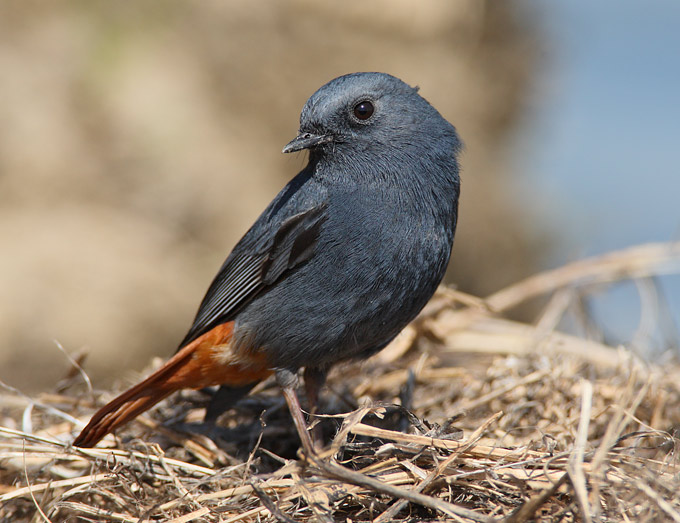
Grey Bushchat Saxicola ferreus V2
A rare spring overshoot, recorded from late March to late May, with most records on offshore islands. One male photographed on Hong Island, Jeollanam Province, on March 26th (PCO, KNPS) is the 11th national record known to Birds Korea. As such its status code will be amended to V1 in the next Checklist update.
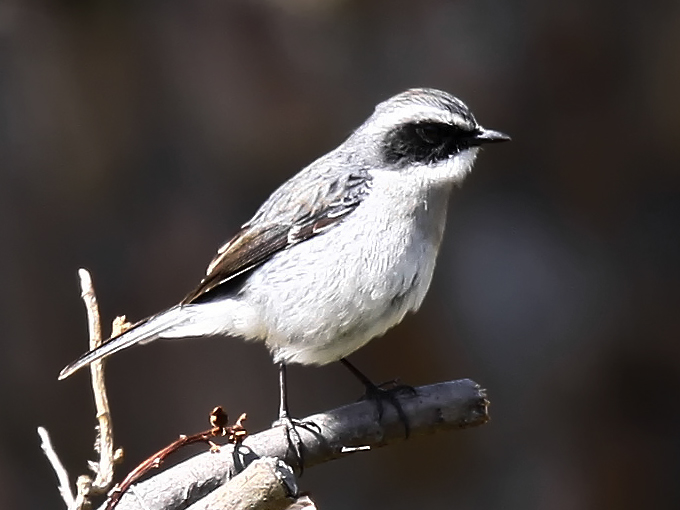
Isabelline Wheatear Oenanthe isabellina V2
One photographed on Weiyeon Island on April 30th (LHW) is the fourth for Korea.
Pied Wheatear Oenanthe pleschanka PV1
A rare migrant recorded from mid-April to early May. One photographed on Hong Island, Jeollanam Province, from April 11th (CDJ) to 18th (KJC) was followed by a male photographed on Socheong Island on May 7th (NM). The latter is approximately the tenth record for the ROK.
Ferruginous Flycatcher Muscicapa ferruginea V2
A rare overshooting migrant, with records between mid-April and mid-May. One on Hong Island, Jeollanam Province, on May 12th (KNPS, 2010) is only the fifth national record.
Chinese Flycatcher Ficedula elisae V2
One possible photographed on Gageo Island, Jeollanam Province, on April 27th (TE) remains under review. It was followed by a presumed female (bright green above and yellow below, with no yellow rump) on Socheong Island, Incheon, on May 18th (NM). Due to the identification challenges posed by this species, there are still only two adequately-documented records.
Red-breasted Flycatcher Ficedula parva V1
A rare migrant, with records in spring, autumn and winter since the first in April 2003. One seen on May 21st and a second sound-recorded on May 28th (NM), both on Socheong Island, Incheon, was followed by onebanded and photographed on Heuksan Island, Jeollanam Province, on November 2nd (KNPS, 2010) – becoming approximately the 17th national record.
Zappey's Flycatcher Cyanoptila cumatilis V2
The split of Cyanoptila cumatilis from Blue-and-White Flycatcher C. cyanomelana was recognized by Birds Korea in 2012 and by the IOC in April 2013, both following Leader & Carey (2012). Reviewed here for the first time. Believed to be a rare, less than annual, overshooting migrant from Chinese breeding grounds to West Sea islands, but status is obscured by poor identification criteria prior to 2012 (e.g. incorrect descriptions provided in Brazil 2009), and even now only males can apparently be identified confidently. One photographed and seen by multiple observers on Jeju Island from April 11th-25th (MP) was followed by another on Socheong Island, Incheon, on April 20th (NM). In May, a possible was on Mungap Island, Incheon, on May 8th (GCS), and one was photographed inland at Bucheon, near Seoul, on May 9th (BJS).
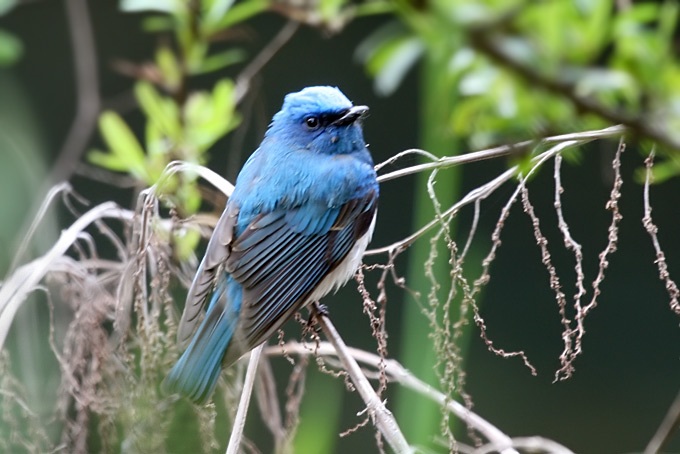
Verditer Flycatcher Eumyias thalassinus V1
A rare but increasingly-recorded migrant to offshore islands recorded between late September and late November since the first in 2001. One First-winter banded on Hong Island, Jeollanam Province, on November 13th (KNPS, 2010) is believed to be the eighth national record.
Fujian Niltava Niltava davidi V2
A female netted and photographed on Mara Island, Jeju Province, on November 13th is the first record for Korea. Identification, already clear from the images and in-hand measurements, was later confirmed by DNA analysis (Kim H-J, Gang C-H, Park S-N et al, 2010).
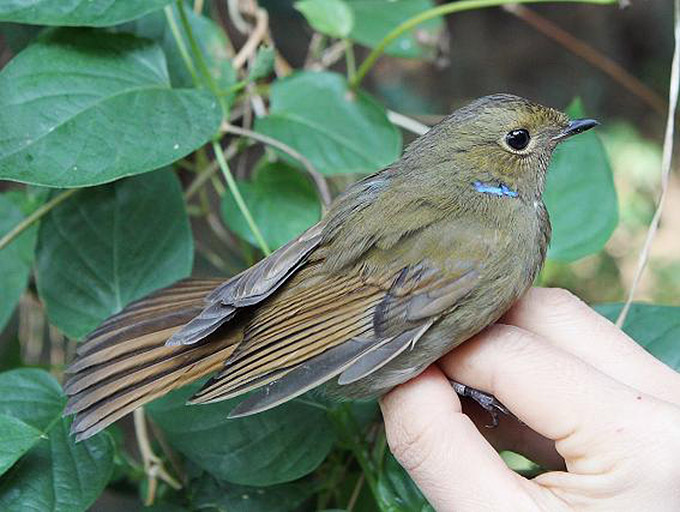
House Sparrow Passer domesticus V2
First recorded in October 2002 (NM). An adult male photographed on Weiyeon Island, Boryeong City, on May 20th (LWM) is the third record for the ROK.
Alpine Accentor Prunella collaris W4
An irregular winter visitor, this species was recorded from three apparently new locations in 2010, being photographed on Seorak Mountain, Gangwon Province on January 10th (MID); Soneun Temple, Gojang County in Jeollabuk Province on February 6th (ODP); and Cheonma Mountain, Gyeonggi Province on April 2nd (YHS).
Citrine Wagtail Motacilla citreola P5
A scarce migrant generally recorded from mid-April to late May, with the rapid increase in records coincident with increased observer coverage. In 2010, there were probably 12 individuals known to Birds Korea, reported from seven locations:
- Jeju Island. A male was seen by multiple observers from April 10th (MP, KYH) to at least April 22nd (KYH).
- Socheong Island, Incheon. Singles were recorded on six dates, first on April 25th, the last on May 25th, with a total of four individuals logged (NM).
- Weiyeon Island, Boryeong City. Two females were photographed on May 1st (CHS, BJS), with one remaining until May 7th (JJOM).
- Gyeongpo Lake, Gangneung (Gangwon Province).A male photographed on May 5th (HJH) is only the fourth mainland record known to Birds Korea.
- Gageo Island, Jeollanam Province. A male seen from May 13th-19th was joined by a female on the 19th (TE).
- Dokjeok Island, Incheon Metropolitan City. One seen on May 21st (DLC, HH) is a first record for the island.
- Hong Island, Jeollanam Province. One was recorded in late May (KNPS, 2010).
White Wagtail Motacilla alba V1
Subspecies baicalensis is a rare but increasingly recorded offshore spring migrant, from late March to early May. One on Socheong Island, Incheon, on April 13th (NM) was followed by one on Eocheong Island, Gunsan City, on April 14th (TE).
Blyth's Pipit Anthus godlewskii P5
A scarce, easy to overlook, passage migrant, recorded from mid-April to early June and again from late August to mid-October. On Gageo Island, Jeollanam Province, singles were seen or photographed on April 18th (RN), April 27th, and (a different, freshly-arrived individual) on April 28th (TE). During northward migration on Socheong Island, Incheon, noted on 19 dates, with the first on April 30th and the last on June 1st, with the highest day count seven on May 19th (Moores 2012).
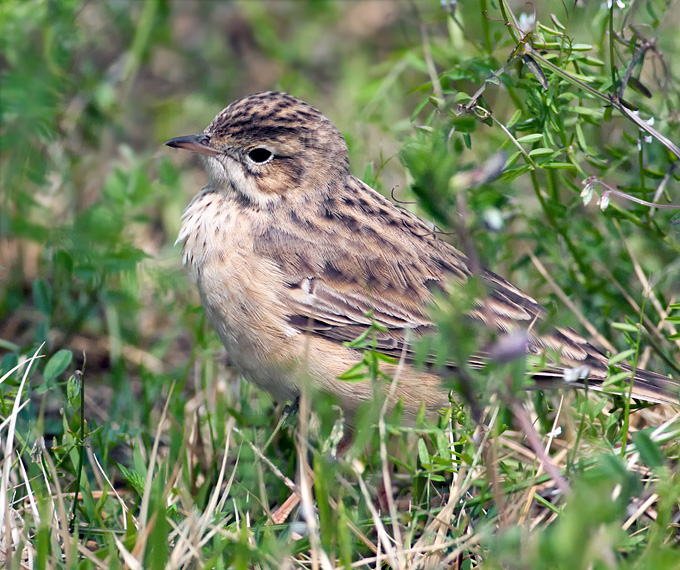
Tree Pipit Anthus trivialis PV1
A very scarce annually-recorded migrant to offshore islands. On Socheong Island, Incheon, one photographed on May 3rd was followed by another on May 18th (NM). One was also photographed on Hong Island, Jeollanam Province, in the “spring” (KJC), with additional records of singles there also on September 16th and in early October (KNPS, 2010).
Water Pipit Anthus spinoletta V1
A very scarce, now probably annual, migrant and winter visitor, recorded from early November to mid-April. One at Ansan Reed Park (on the upper reaches of Sihwa Lake, Sihwa Reclamation Area) first seen on January 7th (OSH) was seen and photographed by multiple observers until January 16th (HJH). There was also one on Socheong Island, Incheon, on April 12th and 13th (NM).
Chinese Grosbeak Eophona migratoria S4, W5 Br:1
Sixty-four on Hong Island, Jeollanam Province, on September 16th (KNPS, 2010) is the largest concentration of this species in 2010 known to Birds Korea.
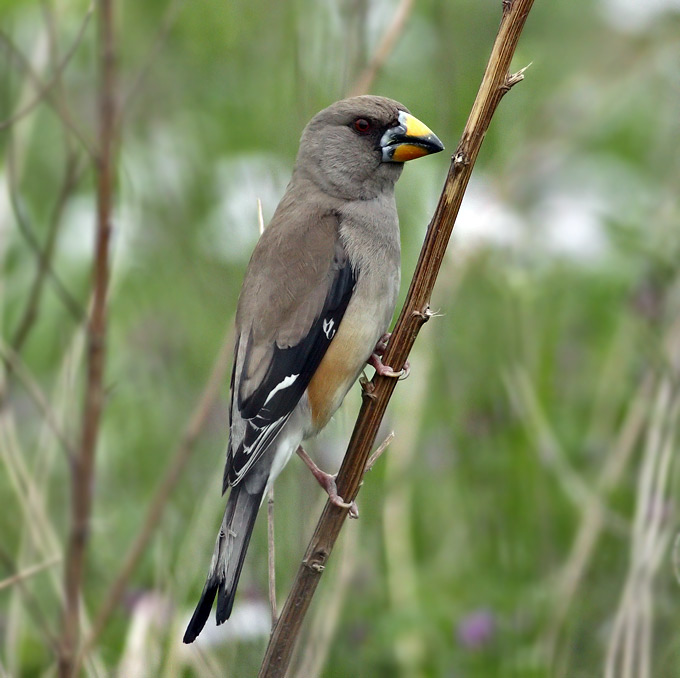
Asian Rosy Finch Leucosticte arctoa WV1
A very scarce and irruptive winter visitor, absent most years. In 2010, however, there were reports from at least six locations:
- Dogyu Mountain, Muju County, Jeollabuk Province. In January, at least one photographed on the 1st (KSK) was followed by ten on the 19th (IKW) and least 12 on the 25th (JJM). At the same site in February, ten were photographed on the 13th (KJC) and 21st (PHS). Finally, 20 were present on March 6th (LDJ) and 12th (KHJ).
- Jiri Mountain National Park, Jeollanam Province. Six or seven were photographed on January 15th (LWM).
- Daebo, Goseong County, Gangwon Province. Thirty-seven were seen on coastal cliffs on January 22nd (NM, AS, CU, FW, GE).
- Busan. At least one was photographed in March (KUJ).
- Odaesan National Park, Gangwon Province.At least one was photographed in November (KNP).
- Jeju Island. On coastal sea-cliffs in the west of the island in November, a flock of 180 on the 20th had dwindled to 30 on the morning of the 27th (KYH), with only two present by the evening of that day (MP). This is the first record for Jeju (Kim H-B et al. 2010), and also the largest flock recorded nationally within the past decade.
Long-tailed Rosefinch Uragus sibiricus P3, W3
An uncommon passage migrant and winter visitor from early October to late April, scarcer southward. Fifty-six on Socheong Island, Incheon, on January 29th (NM) is possibly a new national high day-count.
Godlewski's Bunting Emberiza godlewskii V2
A male photographed and sound-recorded on Socheong Island, Incheon, on April 15th (NM) is Korea's first record.
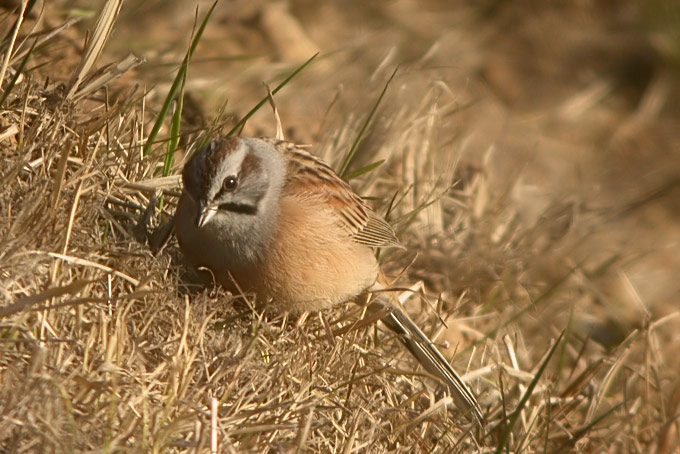
Little Bunting Emberiza pusilla P2, W4
A common passage migrant and uncommon winter visitor, recorded from mid-September to mid-May. During northward migration on Socheong Island, Incheon, recorded on 43 dates, with the first on April 2nd and the last on June 1st and a high day-count of at least 370 on April 28th (Moores 2012), perhaps a new national high day-count.
Yellow-browed Bunting Emberiza chrysophrys P3
An uncommon passage migrant, mostly recorded on offshore islands from mid-April to early June, and from early September to early November. On Socheong Island, Incheon, 175 on May 8th (NM) is believed to be a new national high day-count.
Black-headed Bunting Emberiza melanocephala V1 / Red-headed Bunting Emberiza bruniceps V2
A female or second-calendar-year Black-headed or Red-headed Bunting was seen on Eocheong Island, Gunsan City, on May 12th (PE, TEK).
Yellow Bunting Emberiza sulphurata  P4
P4
One photographed on Mungap Island, Incheon, on May 8th (JSS) is a first record for the island. Singles on Weiyeon Island, Boryeong City, on April 18th and May 30th (PHS) hint at the potential length of the northward migration period, with the latter record the latest date in spring in the ROK known to Birds Korea.
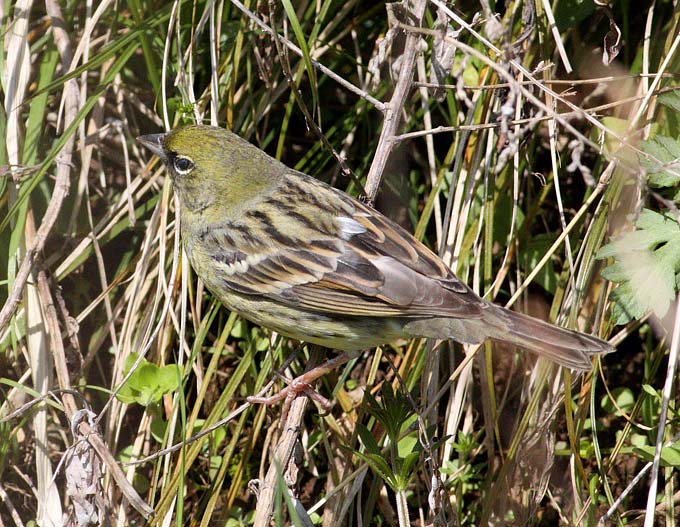
Grey Bunting Emberiza v. variabilis W5, PV1
The only records of the year known to Birds Korea came from Dadapo, Busan, where there was one on January 24th (NM, AS, CU, FW, GE), two on February 22nd (MW, SS) and two on December 12th (DLC).
Ochre-rumped Bunting Emberiza yessoensis  P5, WV1
P5, WV1
A relatively good year for records of this typically scarce species, with a scattering of records in mid-winter and the remainder during migration periods.
- Sihwa Reclamation Area Gyeonggi Province. One photographed on January 10th (PJH) was followed by six on January 19th (PHS), where there were also three on February 14th (TE, DLC). In the second half of the year, one was photographed on November 18th (OSH).
- Yangyang, Gangwon Province. Two were seen on January 21st (NM, AS, CU, FW, GE).
- Suncheon Bay, Jeollanam Province. Singles were seen on February 24th (MW, SS) and May 1st (DLC, HH).
- Heuksan Island, Jeollanam Province. A male was banded and photographed on March 17th (KWY, KNPS), followed by two seen on October 31st (KJC) and one on November 4th (KNPS, 2010).
- Socheong Island, Incheon. During northward migration, recorded on six dates, with the first on April 17th (when the highest day-count of two was recorded) and the last on May 19th (NM).
- Weiyeon Island, Boryeong City. One on May 1st (BJS) was followed by another photographed from May 19th-21st (LWM).
- Hong Island, Jeollanam Province. Singles were recorded in early May, and from late October to mid-November (KNPS, 2010).
- Eocheong Island, Gunsan City. One was photographed on May 9th (SKS).
- Paju, Gyeonggi Province. One was photographed on November 7th (KJC).
Golden-crowned Sparrow Zonotrichia atricapilla V2
Korea's first, one in adult plumage, was found on Weiyeon Island, Boryeong City, on April 10th (KWBS), and was still present to at least the 18th (PHS). This species is a known vagrant to East Asia, and has been recorded both in Japan (according to the Kantori List-server, most recently in 2011) and Eastern Russia (Brazil 2009).
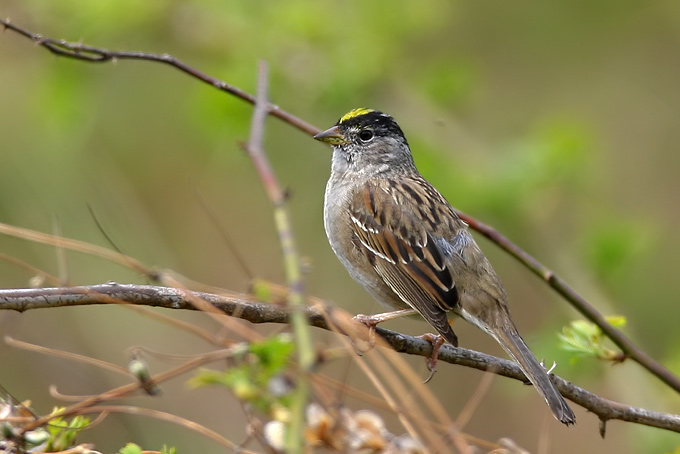
Exotics
The Korean Peninsula is remarkable for the near-absence of introduced bird species, with Feral Pigeon Columba livia perhaps the only well-established and widespread introduced species at this time. Bird-trapping and import of exotics is not widespread when compared with adjacent nations; and the ROK’s interplay of climate, culture and law has helped to reduce the conservation challenge posed by invasive alien bird species. However, in recent years, there has been a small but growing interest in keeping waterbirds in captivity for breeding or display, including imported Crested Ibis Nipponia nippon held at Upo Wetlands for “restoration” (even though the species has never bred here in the wild) and some Anatidae, species. This tendency has grown, stimulated by the Four Rivers project and the rapid growth in Eco-parks and Eco-centres. The following are three non-native species that either escaped or have been deliberately released and were recorded in “the wild” in 2010. These species are included here for completeness and / or because they could pose identification and even possibly conservation challenges in the future:
Canada Goose Branta canadensis V2 (Cat.6)
While this species may have occurred naturally in the ROK (see: 2007 Year Review), it is also increasingly kept and bred as an ornamental in public parks. In 2010 domesticated individuals or populations were photographed at e.g. Cheongju, Chungcheongbuk Province on April 9th (YYM); Daegu City Park in October 11th (HJJ); and at Seoul Grand Park, Gwacheon, Seoul, on November 27th (RSH). Field observers should be aware of structural differences between the two species groups, with the naturally-occurring Cackling Goose B. hutchinsii being much smaller, shorter-necked and stubbier-billed than most Canada Geese.
Black Swan Cygnus atratus
One photographed on the Nakdong Estuary, Busan, on May 21st (KBS) is the first (or one of the first) records of this species in the ROK. As an Australasian species, it seems most likely to have wandered to Korea from neighbouring Japan, where captive and semi-captive populations have existed for several decades at least (Kikawa & Yamashina 1966).
Muscovy Duck Cairina moschata
Domesticated Muscovy Duck (showing a range of plumages from dark to largely white) are occasionally released in the wild. In 2010, individuals were photographed at e.g. Hacheon, Yongin(Gyeonggi Province) on January 21st (SEH); Gyeongpo Lake, Gangneung (Gangwon Province) on February 13th (HJH); and at Ansan (Gyeonggi Porvince) on December 4th (JJOM).
References
- Alström, P, Saitoh, T, Williams, D, Nishiumi, I, Shigeta, Y, Ueda, K, Irestedt, M, Björklund, M and Olsson, U. 2011. The Arctic Warbler Phylloscopus borealis – three anciently separated cryptic species revealed. Ibis 153: 395-410.
- Anon. 2010. Shorebird Monitoring at the Mai Po Inner Deep bay Ramsar Site: 2009-10. Report by Hong Kong Bird Watching Society to the Agriculture, Fisheries and Conservation Department, Hong Kong Special Administrative Region Government
- Austin, O. L., Jr 1948. The birds of Korea. Bulletin of the Museum of Comparative Zoology, Harvard University 101: 1-301.
- Bae Jang-Il. 2009. This winter a rare visitor, the Oriental Stork on Geoje Island. Geoje News, December 2009. (In Korean). Accessible online at: http://www.geojenews.co.kr/news/articleView.html?idxno=13175
- Birds Korea. 2009. Yellow-billed Loon Gavia adamsii. Home-page article, January 2009. http://www.birdskorea.org/Our_Work/Publications/Homepage-articles/BK-HP-Homepage-article-02.2009.shtml
- Birds Korea. 2010. The Birds Korea Blueprint 2010 for the conservation of the avian biodiversity of the South Korean part of the Yellow Sea. Published by Birds Korea, Oct.2010.
- Brazil, M. 1991. The Birds of Japan. Published by Helm.
- Brazil, M. 2009. Birds of East Asia. Published by Princeton Press.
- Choi C-Y., Park J-G., N. Moores, Kim E-M., Kang C-W., Nam H-Y.& Kim S-M. 2011. The recent increase of the Red-billed Starling Sturnus sericeus in the Republic of Korea. Short Notes, Forktail 27:84-86.
- Gang C-H, Kang H-M, Kim E-M, Park C-Y, Ji N-J. 2010. Birds of Jeju. Published by Han Gureu (In Korean).
- Gang C-H, Kim H-J, Kang H-M, Kim E-M, Choi J-H. 2010.Birds of Gwantal Island and their Conservation. Korean Journal of Ornithology, Vol.19 No.1, p.45-51. (In Korean with English Abstract). Accessible online at: http://www.reportshop.co.kr/kstudy/11905953
- Gore, M. & Won P-O. 1971. The Birds of Korea. Published by the Royal Asiatic Society.
- Hong Kong Birdwatching Society (HKBS). 2010. The International Black-faced Spoonbill Census 2010. Accessed in December 2013 at: http://www.hkbws.org.hk/BBS/viewthread.php?tid=12641&extra=page%3D1
- Hur, W-H, Kim, S-H, Kim, J-H, Choi, Y-S, Kang, S-G, Son, J-S. 2011. "A Study on the Migration Route and the Status of wintering and stop over ecology of Migratory Birds". National Institute of Biological Resources (in Korean). Accessed in December 2013 at: http://webbook.me.go.kr/DLi-File/099/004/001/5511034.pdf
- Jeong Sang-Seob, 2010. "Vulture and 500 others at Gosong". Busan Ilbo. (In Korean). Accessible online at: http://m.busan.com/m/News/view.jsp?newsId=20101217000070
- Jin S-D, Han J-R, Yu J-P, Baek I-H, Kim S-H, Park J-Y, Hoh U-H, Kim H-J, Kim J-H, Baek E-G, 2010.First record of Gyrfalcon Falco rusticolus in Korea. Korean Journal of Ornithology, Vol.17 No.3, Pp.285-287. (In Korean with English Abstract). Accessible online at: http://www.reportshop.co.kr/kstudy/11597987
- Ju Y-K. 2012. Research on Black-faced Spoonbill and Shorebirds, within the proposed sites for the Incheon & Ganghwa Tidal Power plants. Powerpoint based on the data of the Korea Waterbird Network.
- Kennerley, P. & D. Pearson. 2010. Reed and Bush Warblers. Helm publication.
- Kikkawa, J. & Yamashina, Y, 1966. Breeding of introduced Black Swans in Japan. Accessible online at: http://www.publish.csiro.au/paper/MU966377.htm
- Kim H-B, Kim Y-H, Oh H-S, 2010. A Study about Checklist Research of the Birds of Jeju Island. Korean Journal of Ornithology, Vol.18 No.1, p.93-113. (In Korean with English Abstract). Accessible online at: http://www.reportshop.co.kr/kstudy/11640357
- Kim Y-H, Kim H-B, Oh H-S, 2010. The Distribution of Black Paradise Flycatcher on Jeju Island and Management. Korean Journal of Ornithology, Vol.18 No.2, p.141-148. (In Korean with English Abstract). Accessible online at: http://www.reportshop.co.kr/kstudy/11666651
- Kim H-J, Gang C-H, Kang H-M, Ji N-J, Kim E-M, Kim J-H, 2010. The First Record of the Long-tailed Skua ( Stercorarius longicaudus) and the Bulwer's Petrel ( Bulweria bulwerii) in Korea. Korean Journal of Ornithology, Vol.18 No.1, p.87-91. (In Korean with English Abstract). Accessible online at: http://www.reportshop.co.kr/kstudy/11640356
- Kim H-J, Gang C-H, Park S-N, Kang H-M, Ji N-J, Kim E-M, Kim J-H, 2010. Identification of FujianNiltava La Touche using Morphological Characteristics and DNA Barcode. Korean Journal of Ornithology, Vol.19 No.2, p.127-131. (In Korean with English Abstract). Accessible online at: http://www.reportshop.co.kr/kstudy/11930215
- Kim N-G. 2010. First observation of a new species, Bulwer's Petrel, on Jeju Island. Yonhap News, August 2010 (in Korean). Accessible online at: http://media.daum.net/society/others/newsview?newsid=20100812120810490&newsid=20100812120810490&photoid=5054&p=yonhap
- Korea National Park Institute (KNPS), 2010. 2010 Annual Report on Migratory Bird Researches. (In Korean). Cited as (KNPS 2010). Accessible online at: http://knps.or.kr/front/bird/bbs/birdDtl.do?menuNo=7060003&bbsId=BIRDM000013
- Leader, P. & G. Carey. 2012. Zappey’s Flycatcher Cyanoptila cumatilis, a forgotten Chinese breeding endemic. Forktail 28 (2012): 121–128.
- Martens, J. 2010. A preliminary review of the Leaf Warbler genera Phylloscopus and Siecercus. Brit. Orn. Occas. Publs 5: 41-116.
- McWhirter, D.W., Ikenaga, H., Iozawa, H., Shoyama, M. & Takehara, K. 1996. A Checklist of the Birds of Okinawa Prefecture. Bulletin of Okinawa Prefectural Museum, Vol.22, pp 32-152. Accessible online at: http://www.cs.le.ac.uk/people/fdv1/BIRDS/OKINAWA/Okinawa.html
- MOE (Ministry of Environment). 1999-2010. Annual Reports of the Winter Bird Census (in Korean).
- Moores, N. 2006. South Korea’s Shorebirds: A Review of Abundance, Distribution, Threats and Conservation Status. Stilt 50: 62-72. Published by the Australasian Wader Studies Group.
- Moores, N. 2007. Selected Records from Socheong Island, South Korea. Forktail 23: 102-124.
- Moores, N. 2012a. A Wild Goose Chase Through The Literature. Published online by Birds Korea, June 2012 (accessed December 2013) at: http://www.birdskorea.org/Birds/Miscellaneous/BK-BM-Wild-Goose-Chase.shtml
- Moores, N. 2012b. The Distribution, Abundance and Conservation of the Avian Biodiversity of Yellow Sea habitats in the Republic of Korea. Unpublished doctoral thesis, University of Newcastle, Australia.
- Moores, N. & A. Kim. 2013. The Birds Korea Checklist for the Republic of Korea: 2013. Accessible online at: http://www.birdskorea.org/Birds/Checklist/BK-CL-Checklist-info-2013.shtml
- Park H-W, Choi S-K, Jeong J-M, Kim J-H, Kim H-J, 2009. An Assessment of Seabird Bycatch in Coastal Fisheries in the East Sea. Korean Journal of Ornithology, Vol.19 No.2, p151-161. (In Korean with English Abstract). Accessible online at: http://www.reportshop.co.kr/kstudy/11930218
- Park, J-Y. 2002. Current status and distribution of birds in Korea. Department of Biology, Kyung Hee University, Seoul (unpublished thesis, in Korean).
- Park J-Y, Park J-G, Choi J-Y, 2013. A Photographic Guide to the Shorebirds of Korea. Published by Nature and Ecology in conjunction with the Korean Wild Bird Society, April 2013. (In Korean). Details online at: http://econature.co.kr/88215
- Park S-W, 2010. "At Suncheon Bay a world-renowned rare stork has appeared". Yonhap News, November 2010 (in Korean). Accessible online at: http://www.yonhapnews.co.kr/society/2010/11/10/0701000000AKR20101110194600054.HTML
- Tomek, T. 1999-2002. The birds of North Korea. Acta Zoologica Cracoviensia 42: 1-217; 45: 1-235 (in English).
- Won I-J, Park J-G, Hong G-P, Kim S-J, Choi J-Y, Bang G-J, Nam H-Y, Choi H-Y, 2010. Migratory Patterns of Birds on Hongdo and Heuksando Islands. Korea National Park Service,2010. (In Korean with English abstract). Accessible online at: http://ebook.knps.or.kr/upload/pdf/c0004.pdf
- Woo, Y-S., 2010. Black Stork Recorded on Imjin River. Yonhap News. (In Korean). Accessible online at: http://boomup.chosun.com/site/data/html_dir/2010/04/07/2010040700532.html
- Yoncheon News, November 2009. Black Stork found among Cranes. (In Korean). Accessible online at: http://yonchon.com/2.0/bbs/board.php?bo_table=news_media&wr_id=953




